
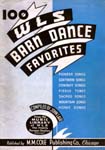


|
 |
Towards the end of December, WSM announced it had become affiliated with the New York hookup that would enable it to broadcast programs from WEAF, the home station of the National Broadcasting Company (NBC). This hookup would enable local listeners to hear such programs as done by grand opera stars, symphony concerts and other programs. However, the new year saw that Nashville was experiencing flooding from a rainstorm. WSM was still not back on the air. But a test program on Wednesday night, December 5, 1927 was successful judging by words, telegrams, letters and cables of approval the station received. WSM did not consider it a formal opening. It included dance music by Vito and his Radio Seven, Jack Keefe of WSM did songs and piano numbers and Obed Pickard, the one-man orchestra, did old-time tunes.
WSM Barn Dance
|
| Time | Artist(s) |
| 8:00 | Johnson City high school orchestra |
| 8:30 | Crook Brothers' barn dance orchestra |
| 9:00 | Dr. Humphrey Bate and his barn dance orchestra |
| 9:30 | T. H. Andrews, guitar; Otle Kellis, fiddle; Paul Womack, mandolin |
| 10:00 | Mankin Ray, violin; R. E. Huggins, guitar; T. J. Givens, banjo |
| 10:30 | D. M. (Deane Moore), the 'Tuneful Tale' Announcer of KFSD, San Diego, California |
| Source: | Nashville Banner - April 16, 1927 |
The formal re-opening of WSM would occur on Friday evening at 6:15 pm January 7, 1927. Beasley Smith's orchestra from the Andrew Jackson hotel would do a dinner concert. Other performers were to be Aleda Waggoner, soprano with Courtney Wagoner Gillespie accompanying her. Elizabeth Breene would also do a piano program. Another soprano, Emmeline Boyer would be accompanied by Florence Boyer. And on the evening went.
The Opry broadcasts began anew on Saturday evening, January 8, 1927.
Soon, the popularity of the show began to grow. Folks would be allowed to come to the studios and listen to the show and be a part of the broadcast. But soon, they outgrew their home.
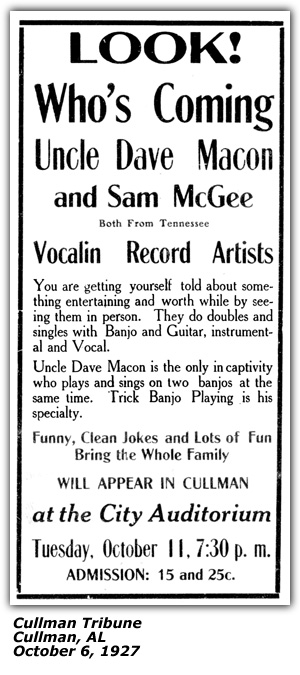
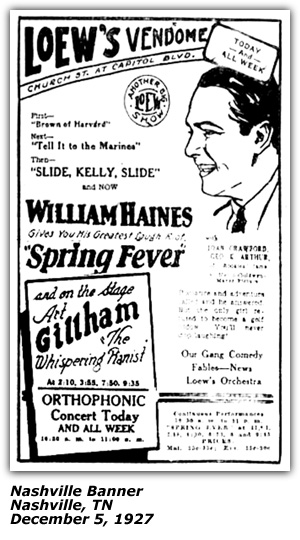
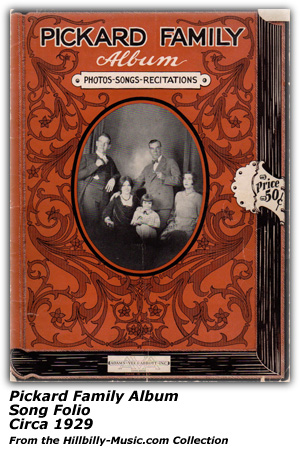 The year of 1927 saw a few programming insertions or interruptions in the normal 8:00 pm to 12:00 am time slot.
For a few weeks, the "Philco Hour from N.B.C. Studios" was slotted from 8:00 pm to 9:00 pm in November and December.
On May 28, 1927, a 90 minute program that originated from NBC in New Orleans was on the air for a flood relief effort. President
Hoover also gave a speech. For the last two weeks in March 1927, a show from New York, "Columbia Phonograph Company" was aired
from 8:00 pm to 9:00 pm. On Saturday night, April 30, 1927, a Hoover-Bullard program originated from New York from 8:00 pm to 9:00 pm.
On May 21, 1927, from 8:00 pm to 9:30 pm, the Nashville Banner sponsored a contest show "Know the South."
The year of 1927 saw a few programming insertions or interruptions in the normal 8:00 pm to 12:00 am time slot.
For a few weeks, the "Philco Hour from N.B.C. Studios" was slotted from 8:00 pm to 9:00 pm in November and December.
On May 28, 1927, a 90 minute program that originated from NBC in New Orleans was on the air for a flood relief effort. President
Hoover also gave a speech. For the last two weeks in March 1927, a show from New York, "Columbia Phonograph Company" was aired
from 8:00 pm to 9:00 pm. On Saturday night, April 30, 1927, a Hoover-Bullard program originated from New York from 8:00 pm to 9:00 pm.
On May 21, 1927, from 8:00 pm to 9:30 pm, the Nashville Banner sponsored a contest show "Know the South."
The Opry also had a couple of guest appearances from The Whispering Pianist, Art Gillham in 1927. He seemed to make appearances in Nashville for special occasions and would have a guest spot on the Opry. He was a nationally known singer who appeared on numerous stations. His biography can be found elsewhere on this site. On June 11, 1927, a program from WRC in Washington was fed into the Opry broadcast.
On August 27, 1927, Will Rogers along with Louise Fasenda and Douglas Fairbanks, Jr. appeared for an hour from the National Press Club in Washington, DC.
Research has shown diversity in the talent on the show. Dan Stafford was a locally known black jazz pianist who appeared on the Opry twice in 1927 - January 29 and March 12. The Elks' Quartet was made up of four black gentlemen that a pictures shows dressed in the style of a barbershop quartet. They were on the Opry on January 29 and February 26. It is an interesting historical note that on Saturday night, January 29, 1927, the Opry broadcast closed with three different black artists or groups - DeFord Bailey on harmonica; The Elks' Quartet; and, Dan Stafford, jazz pianist.
One of the early stars was Obed (One-Man Orchestra) Pickard. He started on the Opry in 1925. He signed a contract with NBC that would begin on October 1 and run through the current season. New York broadcasters thought he was one of the best people who play and sing the old-time melodies. Prior to that contract, he had been working with NBC as part of the Cabin Door program. He also appeared on a program called "Musical Miniatures." He was a versatile musician, playing the guitar, Jews' harp, harmonica and violin.
The reader might be interested to note that the term "Grand Ole Op'ry" did not appear in the local Nashville Newspapers until Sunday, December 18, 1927 in the Nashville Banner. Radio logs would simply state at times, 'Regular barn dance program.'
The St. Louis Globe-Democrat wrote a short article about the popularity of the show they said "The Solemn Old Judge" calls the "Grand Old Opry." Mr. Hay noted in this short blurb that WSM would get hundreds of communications by wire during each program. Listeners would get to hear tunes such as "Old Dan Tucker," "Sally Goodin," "Turkey in the Straw," "Leather Breeches," and "Arkansas Traveler." WSM noted that it was "...surprising to note the interest manifested in the old-time tunes which are played by the banjo pickers and fiddlers from the Tennessee hills during the Saturday night "Barn Dance" program.
Part of Opry lore is that The Solemn Old Judge, George D. Hay would give names to the various acts on the Opry. In the early days, many of the bands were referred to as 'orchestra' or 'barn dance orchestra.' Gradually, radio logs would show the introduction of the names that were given to these groups. On February 26, 1928, the WSM radio log listed Paul Womack and his Gully Jumpers was seen for the first time. On April 28, 1928, the name Binkley Brothers Clod Hoppers is listed in the radio logs for the first time. On May 5, 1928, radio logs showed Dr. Humphrey Bate and his Possum Hunters for the first time.
| Time | Artist(s) |
| 8:00 | Barn dance program: |
| Obed Pickard, one-man orchestra | |
| DeFord Bailey, harmonica wizard | |
| Bert Hutchison, guitarist | |
| Dr. Humphrey Bate and his orchestra | |
| W. E. Poplin and orchestra | |
| Theron Hale and daughters | |
| Paul Womack and his orchestra | |
| Source: | Nashville Banner - April 21, 1928 |
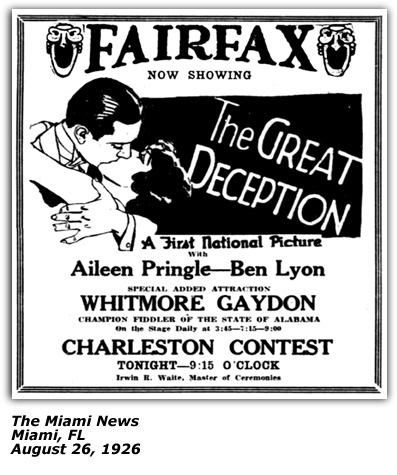 In 1928, the Opry was showing a regular roster of performers. DeFord Bailey, the harmonica wizard, was on 67
segments of the Opry as shown in the newspaper radio logs. That is more than twice the number of the next
most frequent artists such as Dr. Humphrey Bate, Paul Womack, Obed Pickard.
In 1928, the Opry was showing a regular roster of performers. DeFord Bailey, the harmonica wizard, was on 67
segments of the Opry as shown in the newspaper radio logs. That is more than twice the number of the next
most frequent artists such as Dr. Humphrey Bate, Paul Womack, Obed Pickard.
Some new faces appeared on the Opry as well. Mrs. G. R. Cline (Kitty Cora Denning Cline), a dulcimer player first appeared on March 24, 1928 and would continue to appear in the years to come. She lived in a small town where traveling to Nashville on Saturday night required her to get help from friends and reimbursing them for gas and oil for traveling the dirt roads. But she gave that up. There is a historical marker of sorts at her grave denoting her place in country music history.
Along about May 26, 1928, a champion fiddle player made his debut on the Opry - Whitmore (Whit) Anderson Gaydon. He was born in Auraria, Georgia, but his life took him to many cities around the country. He appears to have lived in North Carolina, Florida, Tennessee, Alabama and California and then some. He was also a prolific writer of essays that appeared in newspapers, offering opinions and observations from his travels. He ended up in California, where he was living with his brother's family at the time of his death. He tried to start a Fiddler's Convention or Contest when he was in Miami - trying to lure Henry Ford to attend. Mr. Ford had held a fiddling contest in years prior and Whit wanted to model the one in Miami after it. In all, he was on the Opry eight times in 1928 but one wonders if he provided any of his opinions or observations during his performances on the show.
Smiling Ed McConnell was on the Opry in 1928 by selling Aladdin Lamps. He was heard on WSIX Monday through Friday at 9:00 am, singing "...all the favorite hymns for which millions have learned to love him so deeply." His sponsor for that show was Rich Hear Flour, which was a new product that contained the wheat germ of the whole wheat kernel. In December 1928, introduced the character "Uncle Wash" as a comedic effort. He would work with the Solemn Old Judge and their skits would be known as "Uncle Wash and the Judge" in 1929. He would close the Opry broadcast on Saturday nights in "songs and stories."
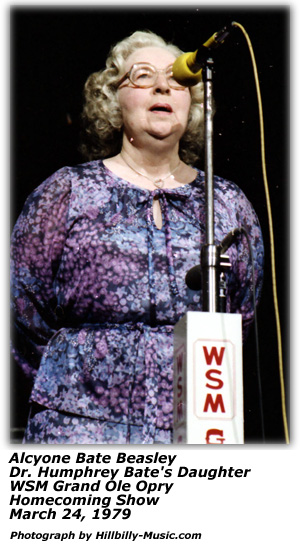
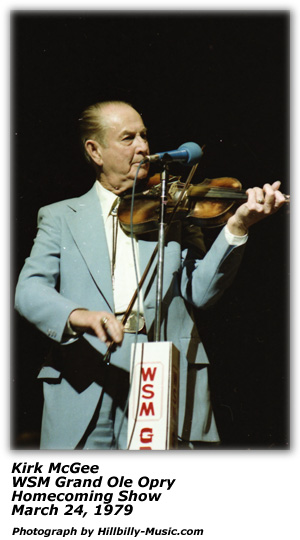

|
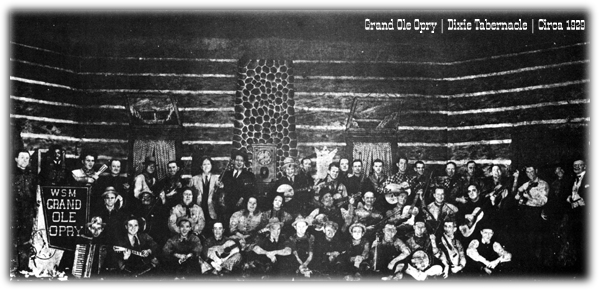
|
| First (Front) row: Bobby Castleman, Jack Shook, Nat Bastien, Kurt Poulton, Tommy Lefew, Howard Ragsdale, George Wilkerson, Claude Lampley, Gale Binkley, Amos Binkley, Tom Andrews, Mr. George |
| Second row: Dee Simmons, Walter Liggett, Dr. Humphrey Bates, Sally, Sarah, Uncle Dave Macon, Ed Poplin, Jack Woods, Robert Lunn, Paul Krock |
| Third row: David Stone, DeFord Bailey, Buster Bates, Roy Hardison, Staley Walton, Charlie Arrington, Oscar Stone, Honey Wilds Lasses White, Lewis Crook, Dorris Macon, Herman Crook, Bert Hutchison, Ed Poplin, Jr., Rabon Delmore, Sid Harkreader, Alton Delmore, Arthur Smith, Sam McGee, Kirk McGee, Mr. Albright, Judge George D. Hay |
| Time | Artist(s) |
| 8:00 | Uncle Wash and the Judge |
| 8:15 | Dr. Humphrey Bate and his Possum Hunters |
| 8:45 | DeFord Bailey, harmonica wizard |
| 9:00 | Crook Brothers barn dance orchestra |
| 9:30 | Uncle Joe Mangrum, fiddle and Fred Shriver, accordion |
| 10:00 | Dr. Humphrey Bate and his Possum Hunters |
| 10:30 | Dixie Serendading Band |
| 11:00 | DeFord Bailey, harmonica |
| 11:15 | Ed McConnell in songs and stories |
| Source: | The Nashville Tennessean - April 20, 1929 |
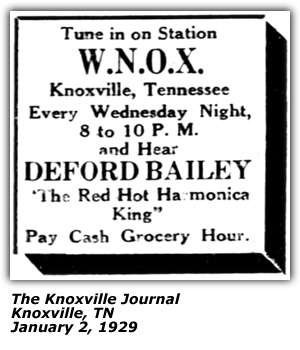 The year of 1929 featured several mainstay Opry string bands — G. W. Wilkerson's Fruit Jar Drinkers,
the Crook Brothers' barn dance orchestra, Dr. Humphrey Bate and his Possum Hunters, W. E. Poplin and his
orchestra and Paul Womack and his Gully Jumpers. These bands accounted for over a third of
the time segments listed in the radio log listings on Saturday nights.
The year of 1929 featured several mainstay Opry string bands — G. W. Wilkerson's Fruit Jar Drinkers,
the Crook Brothers' barn dance orchestra, Dr. Humphrey Bate and his Possum Hunters, W. E. Poplin and his
orchestra and Paul Womack and his Gully Jumpers. These bands accounted for over a third of
the time segments listed in the radio log listings on Saturday nights.
DeFord Bailey, the harmonica wizard was popular appearing in more time slots than any artist. Others that appeared in more than 20 time slots were Theron Hale and his daughters, Arthur and Homer Smith, Uncle Joe Mangrum and Fred Shrive, Burt (Bert) Hutchison (Hutchinson). This group of artists appeared in nearly 45 percent of the Opry listings for 1929.
A new performer appeared for a time - Smiling Ed McConnell. He had a couple of slots on the Opry for several months. He usually led the Opry with "Uncle Wash and The Judge." This popular segment ran from the first of January to about mid-May 1929. Then he had a segment that usually closed the Opry show called "Ed McConnell in songs and stories."
Uncle Wash was Ed McConnell; The Judge was George D. Hay. It caught on quick. In January of 1929, the Associated Press sent out a short paragraph that simply stated, "Ed McConnell and George D. Hay are presenting the trials and tribulations of "Uncle Wash" before the microphone of WSM, Nashville, each Saturday night."
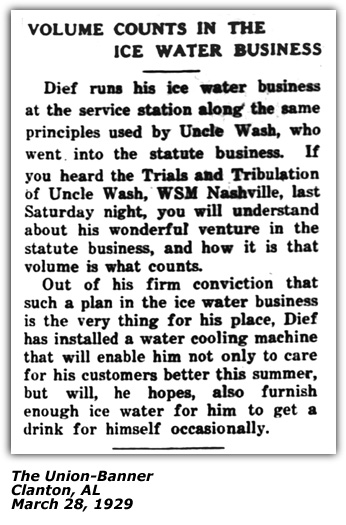 In the first week it aired on the Opry, we learn that Ed McConnell had originated the character and had been featuring
it on WSM programs for the past two months. The story goes "...Uncle Was was put in city jail at Nashville and in the effort
to release him have come petitions from various citizens of Indiana, Alabama and several other states. ... In the mail
to WSM the other day a legal document appeared which was signed by T. O. Cullins, justice of the peace in Ada, Oklahoma,
with the goodwill of Governor Henry Johnson, Orel Busby, district judge and W. R. Walker, sheriff. It even garnered mention
in those small paragraphs mentioning where people spent a weekend when several folks from Clarksville "...motored to
Nashville Friday to visit so and so. Saturday evening they visited radio station WSM to see and hear Uncle Wash and
The Solemn Old Judge."
In the first week it aired on the Opry, we learn that Ed McConnell had originated the character and had been featuring
it on WSM programs for the past two months. The story goes "...Uncle Was was put in city jail at Nashville and in the effort
to release him have come petitions from various citizens of Indiana, Alabama and several other states. ... In the mail
to WSM the other day a legal document appeared which was signed by T. O. Cullins, justice of the peace in Ada, Oklahoma,
with the goodwill of Governor Henry Johnson, Orel Busby, district judge and W. R. Walker, sheriff. It even garnered mention
in those small paragraphs mentioning where people spent a weekend when several folks from Clarksville "...motored to
Nashville Friday to visit so and so. Saturday evening they visited radio station WSM to see and hear Uncle Wash and
The Solemn Old Judge."
On Saturday, September 7, 1929 the Opry broadcast over WSM Was delayed by two hours for a special radio program - the Nashville Banner's third annual radio show. The annual show would start at 8pm and run to 10pm. The entertainment on the two hour show would include Olive Palmer, Muriel LaFrance, Baby Jean (a vaudeville star), Frances Craig, Vito and the Pickard family. The show (which ran several days) was broadcast on WSM And WLAC. Murel LaFrance closed the show.
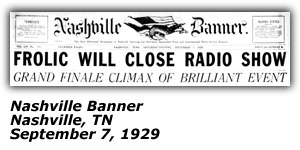
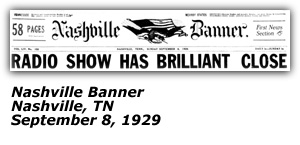
The Opry broadcast was pre-empted one evening (October 5, 1929) for a special show by WSM celebrating the fourth anniversary of the station. The celebration was called "Gold Filled Chain" and would be heard starting at 8:00 pm and be heard over a five station hookup. The show was planned to run until about 2am. Guest announcers would be a part of the broadcast: Phillips Carlin of NBC in New York; Leo Fitzpatrick (The Merry Old Chief) from WJR in Detroit, Lambdin Kay (The Little Colonel) from WSB in Atlanta, Walter Campbell of WAPI in Birmingham and Bucky Harris of WMC in Memphis. The schedule called for an "...elaborate musical presentation" to start the show. Two hours would contain samples of WSM's broadcast schedule.
At 10:00 pm the five station hookup would be consummated "...at which time a burlesque of chain broadcasting and other radio features will be given by the visiting announcers." The 'frolic' would begin at midnight.
WSM would be represented by The Solemn Ol' Judge, George D. Hay, Harry Stone and Jack Keefe doing announcing chores. Some of the WSM artists scheduled to appear were Christine Lamb, contralto; Tom and Joe, Minstrel Men; Lillian Watt, soprano; John Carter, tenor; Fred Shriver, accordionist and DeFord Bailey, harmonica wizard.
| Time | Artist(s) |
| 8:00 | Dr. Humphrey Bate and his Possum Hunters |
| 8:30 | DeFord Bailey, harmonica |
| 8:45 | Jack and Bill |
| 9:00 | Crook Brothers Barn Dance Orchestra |
| 9:30 | Paul Womack and his Gully Jumpers |
| 10:00 | Bulova watch time |
| 10:01 | Taylor weather bulletin |
| 10:02 | Theron Hale and daughters |
| 10:30 | Amos 'n' Andy, NBC Studios |
| 10:45 | Jack and Bill |
| 11:00 | DeFord Bailey, harmonica |
| 11:15 | Uncle Joe Mangrum and Fred Shriver |
| 11:35 | G. W. Wilkerson and his Fruit Jar Drinkers |
| Source: | Nashville Banner - April 19, 1930 |
Based on a review of the WSM Radio Logs in the Nashville Banner and the Tennessean in 1930, the Opry had relatively few different artists listed as hosting segments. The newspapers do not show if any guests appeared on those segments. By far, DeFord Bailey and his harmonica appeared on over 100 time slots on Saturday nights. Dr. Humphrey Bate and his Possum Hunters opened the show all 52 weeks.
String bands seemed to alternate their appearances over the year - W. E. Poplin and his Orchestra; Crook Brothers Barn Dance Orchestra, G. W. Wilkerson and his Fruit Jar Drinkers, and, Paul Womack (Warmack) and his Gully Jumpers. Theron Hale and his two daughters might be considered in this grouping.
Theron Hale and his two daughters made numerous appearances as did Arthur and Homer Smith.
Uncle Dave Macon appeared about 20 times with his son Dorris and on one occasion is listed being with Sid Harkreader.
There were several artists that made singular or very few appearances as host of a segment, Ken Hackley and his Oklahoma Cowboys appeared in December. Chief Kiutus Tecumseh, an Indian tenor, made an appearence in 1930. Henry Whitter, banjo picker was another who appeared.
During 1930, the NBC network show, Amos 'n' Andy was listed as a 15-minute segment among the Opry lineup on Saturday night, usually at 9:30 pm or 10:30 pm.
The Opry had a couple of unusual one-minute listings, probably for sponsors. One was for Bulova Watch Time and the other was for Taylor Weather Bulletin. These spots were listed all through 1930.
Uncle Joe Mangrum and Fred Shriver made about 24 appearances. Uncle Joe played the fiddle or in some cases, violin. Fred Shriver played the accordion, piano and guitar to accompany Mr. Mangrum.
But perhaps the one that caused extra research were the segments for "Jack and Bill." The became a team in the spring of 1930 with the arrival of the husband and wife team, "Jack and Jill." Jack was an organist and piano player. The duo had started their own show at 7pm on Saturday nights. "Jill" handled the comedy of the team. Billy was a tenor on WSM at the time and was often accompanied by a pipe organ player such as Margo Sheets. He was on twice a week at the time. But in April, WSM started a new show called "Jack and His Music Shop" — Jack was at the piano and Billy was singing tenor.
Billy O'Connor achieved some fame in 1928 when he and Christine Lamb, contralto, won the Tennessee state contest in what was the second annual radio audition. That meant they would participate in the semi-finals in Nashville on November 14 and 15, competing against other state champions from the southern states. The national finals would be in New York on December 16 with cash prizes totaling $17,500 to be awarded by the Atwater Kent Foundation.
"Jack" was the piano player of the duo. His real name was Jack Thurston (Thursten). His wife, who was "Jill" in their act, was Jacqueline. Jack and his wife came to WSM in early 1930. The combination of Jack and Bill proved to be a winning one for WSM as their show became very popular. At first they were on before the Opry in "Jack and Bill's Music Shop." The two of them had an idea to 'sell songs over the radio.' It was only a farce J. W. West of The Nashville Banner told readers, but the premise of the show 'clicked' with the audience. He wrote, "...when a person wishes to hear a number, he just writes or calls the radio station and the song is "sold" to him over the air promptly. Their show aired a couple of times a week also.
News columns would tout the popularity of the show - it was reported they were getting requests by the hundreds. Jack was said to be a pianist of "...decided ability..." while Bill's "...tenor voice is a big drawing card." But by the end of 1930, their run ended. Jack and his wife decided to move to Florida where he enjoyed a career on radio in the Miami area. However, the two of them died in the early to mid-1940's. More details will be found in separate biographies for Billy O'Connor and Jack Thurston (Thursten).
| Time | Artist(s) |
| 8:00 | Dr. Humphrey Bate and his Possum Hunters |
| 8:45 | DeFord Bailey, harmonica |
| 9:00 | W. E. Poplin and his Orchestra |
| 9:30 | Paul Warmack and his Gully Jumpers |
| 9:59 | Leon Taylor weather bulletin |
| 10:00 | Amos 'n' Andy (NBC) |
| 10:16 | Mazy Todd and Fred Haley |
| 10:30 | G. W. Wilkerson and his Fruit Jar Drinkers |
| 11:00 | Theron Hale and Daughters |
| 11:25 | DeFord Bailey, harmonica |
| 11:35 | Crook Brothers Barn Dance Orchestra |
| Source: | Nashville Banner - April 11, 1931 |
| Time | Artist(s) |
| 8:00 | Dr. Humphrey Bate and his Possum Hunters |
| 8:25 | Uncle Dave Macon and Dorris Macon |
| 8:50 | DeFord Bailey |
| 9:00 | Crook Brothers Barn Dance Orchestra |
| 9:30 | Paul Warmack and his Gully Jumpers |
| 10:00 | Amos 'n' Andy (NBC) |
| 10:15 | The Vagabonds |
| 10:30 | Theron Hale's Band |
| 11:00 | DeFord Bailey |
| 11:10 | Binkley Brothers Dixie Clod Hoppers |
| 11:30 | G. W. Wilkerson and his Fruit Jar Drinkers |
| Source: | Nashville Banner - April 16, 1932 |
The year of 1932 saw the program gaining attention. The "grand old opry" as it was called in news articles was going to get a network tryout. WEAF-NBC was going to give the six year old show a trial on February 6, 1932. News reports stated "...This program consists of old favorites many of which have never been scored. The pickup is to be another in the series of outstanding half hours from individual stations on the network."
The Nashville Tennessean in a column in March 1932 used another variation of the show's name when telling readers that WSM "Saturday night's Grand Ole Op'ry brings the usual line-up of barn-dance orchestras..."
In November 1932, WSM made a change to the station that would have lasting impact on the station's growth as well as the fame of its Saturday night show. November 12 was to be the evening when WSM would dedicate and begin broadcasting from its new 50,000 watt transmitter and 878-foot tall antenna. This event was to be a national celebration. A November 6 article leads off, "WSM Is on the air!" That was the name of the program given to highlight the event staged by the National Life and Accident Insurance Company that would originate from its new studios as part of the dedication. A formal opening of the festivities would begin at 8:00 pm. NBC's network program would kick in at 10:15 pm from New York. Programs from a half dozen cities around the country would be broadcast before turning it back over to WSM an hour later.
| Time | Artist(s) |
| 8:00 | Dr. Humphrey Bate and His Possum Hunters |
| 8:30 | Uncle Dave Macon and Dorris |
| 9:00 | DeFord Bailey |
| 9:10 | Four Boys |
| 9:15 | William E. Poplin and his Gully Jumpers |
| 9:45 | Paul Warmack and his Gully Jumpers |
| 10:15 | The Vagabonds |
| 10:30 | Arthur Smith and his Dixie Liners |
| 10:55 | Four Boys |
| 11:00 | G. W. Wilkerson and his Fruit Jar Drinkers |
| 11:30 | DeFord Bailey |
| 11:40 | Crook Brothers Barn Dance Orchestra |
| Source: | Nashville Banner - April 22, 1933 |
In 1933, Asher Sizemore and Little Jimmie could be one of the first stars of the Grand Ole Opry. They appeared on Saturday nights 42 times in 1933. Promotional ads touting Grand Ole Opry performers show perhaps the rural nature of the audience at that time since driving long distances was not the same as today's faster automobiles and modern highways. One could see the ads were found in Kentucky, Indiana, Illinois and Ohio.
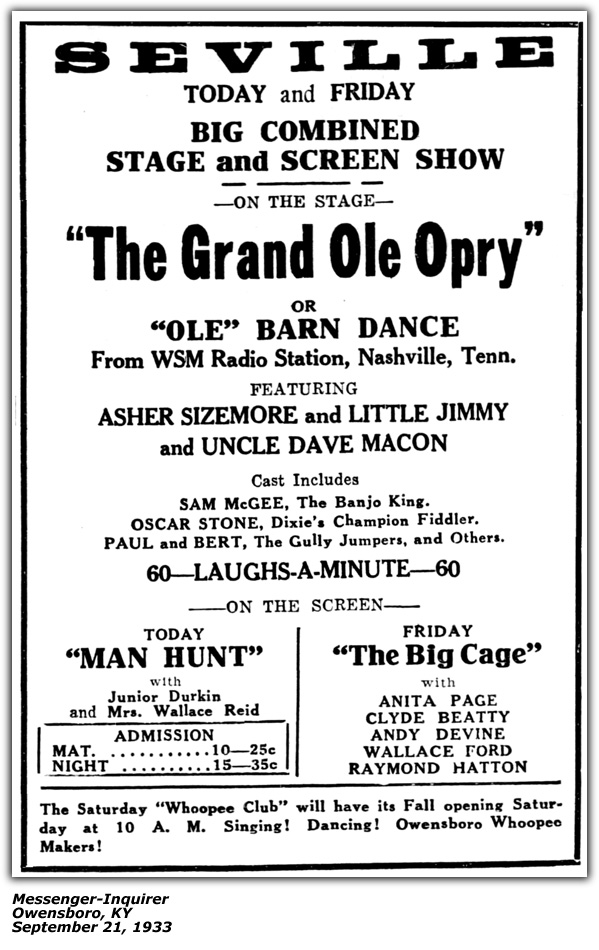
| Time | Artist(s) |
| 7:30 | Delmore Brothers |
| 7:45 | Vagabonds |
| 8:00 | Dr. Humphrey Bate and His Possum Hunters |
| 8:10 | Uncle Dave Macon |
| 8:20 | W. E. Poplin and his Barn Dance Orchestra |
| 8:30 | Theron Hale's Band |
| 8:40 | Lasses and Honey |
| 8:50 | The Vagabonds |
| 9:00 | Dr. Humphrey Bate and His Possum Hunters |
| 9:10 | Uncle Dave Macon |
| 9:20 | G. W. Wilkerson and his Fruit Jar Drinkers |
| 9:30 | W. E. Poplin and his Barn Dance Orchestra |
| 9:40 | DeFord Bailey |
| 9:50 | Paul Warmack and his Gully Jumpers |
| 10:00 | Arthur Smith and his Dixie Liners |
| 10:15 | Nap and Dee |
| 10:20 | G. W. Wilkerson and his Fruit Jar Drinkers |
| 10:30 | Big Yank Southerners |
| 10:45 | Robert Lunn |
| 10:50 | Nap and Dee |
| 10:55 | DeFord Bailey |
| 11:00 | The Vagabonds |
| 11:10 | Crook Brothers Band |
| 11:20 | Theron Hale's Band |
| 11:30 | Paul Warmack and his Gully Jumpers |
| 11:40 | Arthur Smith Dixie Liners |
| 11:50 | Crook Brothers Band |
| Source: | The Nashville Banner - April 21, 1934 |
The Johnson City Press started off a promotional piece for the Grand Ole Opry troupe that was coming to town this way:
"Whoopem up Cindy, an' cook dat 'possum brown, ca'se de Grand Ole Opry is coming to town.!"
 The column noted that in ten years, the show had grown from a one-act performance for one hour to a four-hour show that
had 60 people. The article stated that the show an average of over 50,000 letters a week from every state in the country and from
foreign countries such as Canada, Mexico and Central American countries.
The column noted that in ten years, the show had grown from a one-act performance for one hour to a four-hour show that
had 60 people. The article stated that the show an average of over 50,000 letters a week from every state in the country and from
foreign countries such as Canada, Mexico and Central American countries.
The audience in Johnson City would see nine of the most popular acts on the Opry at that time that included 20 artists such as Uncle Dave Macon, the Sweeney Sisters, and, DeFord Bailey. They wrote, "The program contains an hour of rhythm, comedy and instrumental numbers, with hillbilly songs and showmanship."
Research will also reveal some names that Opry fans may not be familiar with. Perhaps they were not famous enough to warrant a segment of their own, but were guest stars on the show but not listed in the weekly listings. In 1935, the Arend Trio was one such group.
Leon and Helen Arend were the parents of the three sisters. The family was from Paulding, Ohio. The trio won first place in the WOPI amateur hour contest in 1935.
They were Margie (B: May 29, 1922 — D: July 2, 1995); Eualala (B: August 9, 1923 — D: November 26, 1983); and, Rosalie (B: June 11, 1925 — D: June 24, 1992).
In 1935, their ages would have been 10, 12 and 13. Promotional ads billed them as a "novelty act."
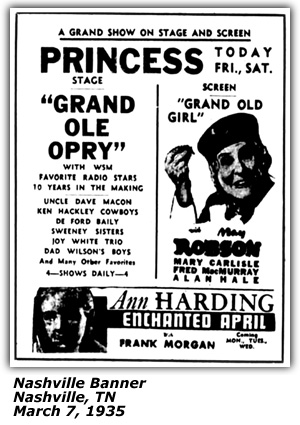
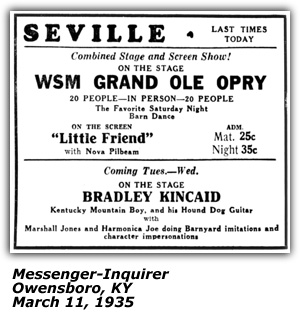
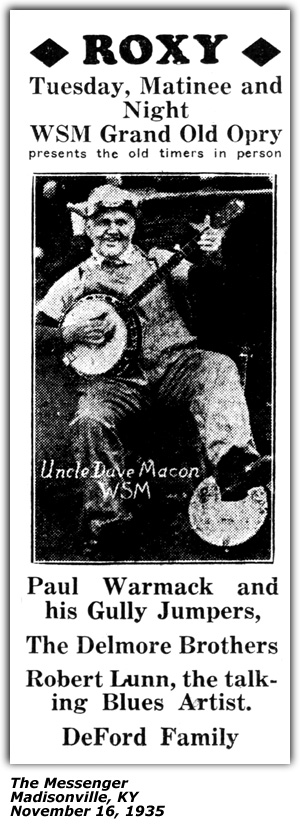
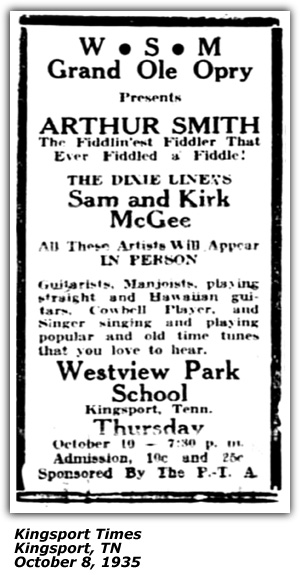
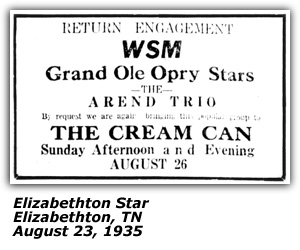
| Time | Artist(s) |
| 7:00 | Lasses White's All-Star Minstrel Show |
| 7:30 | Smilin' Jack Shook and his Missouri Mountaineers |
| 7:45 | Delmore Brothers |
| 8:00 | Possum Hunters |
| 8:10 | Uncle Dave Macon |
| 8:20 | Gully Jumpers |
| 8:30 | Arthur Smith and his Dixie Liners |
| 8:42 | Sarie and Sallie |
| 8:47 | Smilin' Jack Shook and his Missouri Mountaineers |
| 9:00 | Lasses and Honey |
| 9:15 | Curt Poulton and his Guitar |
| 9:30 | Possum Hunters |
| 9:40 | Uncle Dave Macon |
| 9:50 | Ed Poplin and his Band |
| 10:00 | Delmore Brothers |
| 10:10 | Arthur Smith and Dixie Liners |
| 10:20 | Crook Brothers' Barn Dance Band |
| 10:30 | Fruit Jar Drinkers |
| 10:35 | Ard Sisters |
| 10:40 | Fruit Jar Drinkers |
| 10:45 | Robert Lunn |
| 10:50 | Crook Brothers Band |
| 11:00 | Delmore Brothers |
| 11:10 | Gully Jumpers |
| 11:20 | Ed Poplin and his Band |
| 11:30 | Fruit Jar Drinkers |
| 11:40 | Ard Sisters |
| 11:50 | Smilin' Jack and his Missouri Mountaineers |
| Source: | The Nashville Tennessean - April 20, 1935 |
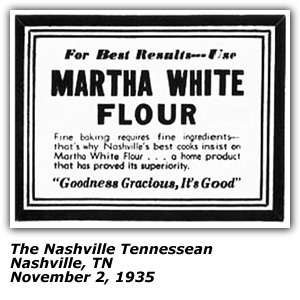
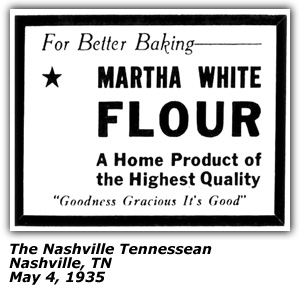
| Time | Artist(s) |
| 7:00 | Hilltop Harmonizers |
| 7:15 | Sarie and Sallie |
| 7:30 | Jack Shook and his Missouri Mountaineers |
| 7:45 | Delmore Brothers |
| 8:00 | Possum Hunters |
| 8:10 | Uncle Dave Macon |
| 8:20 | Gully Jumpers |
| 8:30 | Dixie Liners |
| 8:40 | Curt Poulton |
| 8:50 | Jack Shook and his Missouri Mountaineers |
| 9:00 | Lasses and Honey |
| 9:10 | Fruit Jar Drinkers |
| 9:20 | Delmore Brothers |
| 9:30 | Ed Poplin and Band |
| 9:40 | Sarie and Sallie |
| 9:45 | DeFord Bailey |
| 9:50 | Possum Hunters |
| 10:00 | Dixie Liners |
| 10:10 | Uncle Dave Macon |
| 10:20 | Crook Brothers |
| 10:30 | Sid Harkreader |
| 10:37 | Delmore Brothers |
| 10:45 | Robert Lunn |
| 10:50 | DeFord Bailey |
| 10:55 | Ed Poplin and his Band |
| 11:05 | Curt Poulton |
| 11:15 | Crook Brothers' Band |
| 11:30 | Gully Jumpers |
| 11:40 | Sam and Kirk McGee |
| 11:50 | Binkley Brothers |
| Source: | Nashville Banner - April 4, 1936 |
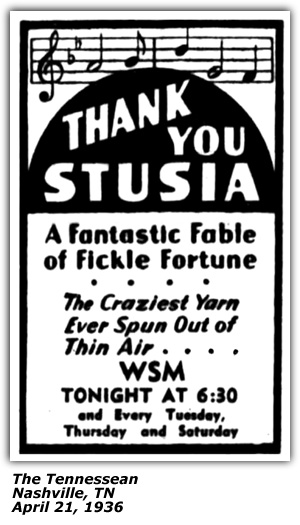 In 1936, the programming on WSM included something different from
the networks on Saturday nights (as well as on Tuesdays and Thursdays).
It was a comedy show called "Thank You, Stusia."
In 1936, the programming on WSM included something different from
the networks on Saturday nights (as well as on Tuesdays and Thursdays).
It was a comedy show called "Thank You, Stusia."
The comedy series revolved around the fictional character of Stusia Pennypacker who wanted to give away her fortune. You can read more about the program in Stusia's biography on this site. And April 1 was part of the story line as well.
The Grand Ole Opry show for Saturday, June 28, 1936 was unusual. The show was delayed to enable WSM to broadcast the acceptance speech by President Franklin D. Roosevelt at the Democratic Party convention.
One news article commented, "Only for President Roosevelt would the barn dance strains give way and as soon as he finishes the little matter of his acceptance speech, they'll be coming around the mountain as big as ever."
Research indicates that the manufacturers of Duck Head overalls were going to sponsor a portion of the Grand Ole Opry. They would sponsor the 7:45pm segment that featured the Delmore Brothers.

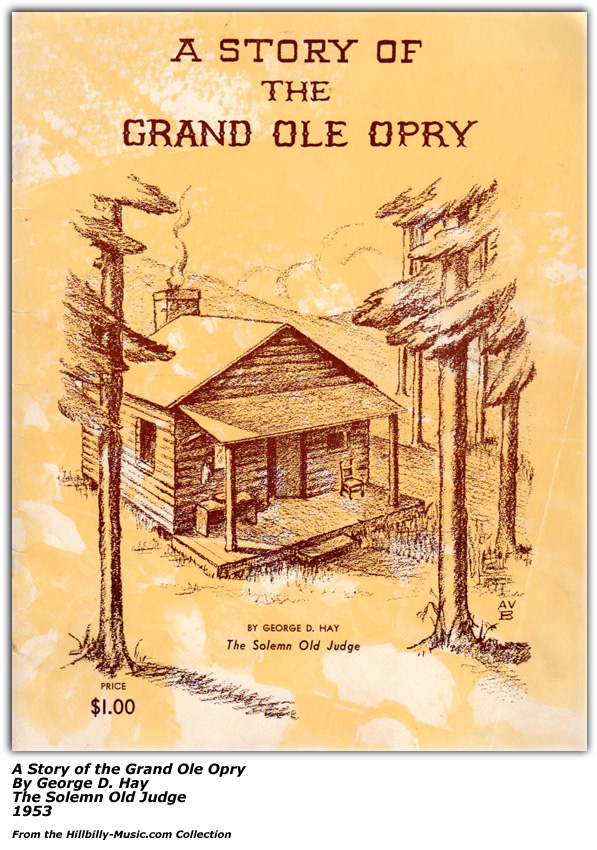
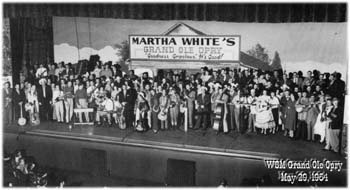
The year of 1937 started a bit ominously weather wise. Rains caused flooding of the Ohio and Mississippi Rivers ravaging communities in its wake. WHAS in Louisville lost power for a time and WSM turned over its facilities to enable WHAS to broadcast updates to its surrounding communities. The Nashville Banner does not show any issues for January through mid-April 1937 per the online archives. The Nashville Tennessean did not publish a radio log for WSM on Saturday, January 30, 1937. This may be one of the rare times the Opry did not air.
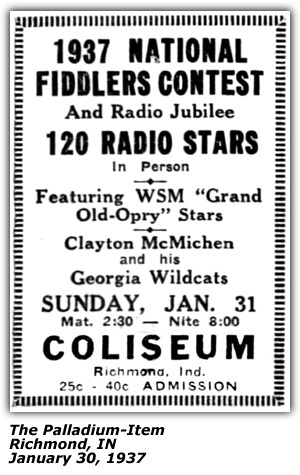
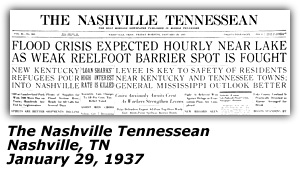
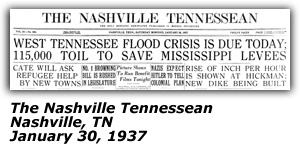
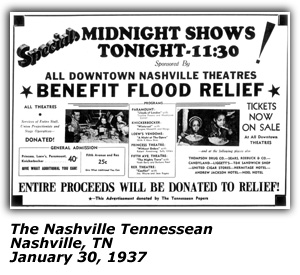
On May 15, 1937, Bob Wills and the Texas Playboys made their first appearance on the Grand Ole Opry. The radio logs in The Nashville Tennessean spelled his name "Bob Wells." The radio log in the Nashville Banner had changed to a new grid format where it showed time segments for every 15 minutes of the hour, thus, it would list fewer acts than the log in The Nashville Tennessean. Bob appeared at 9:40pm according to The Nashville Tennessean; the Nashville Banner only shows the two acts that appeared before and after him - Delmore Brothers at 9:30 and Poplin's Band at 9:45.
Another notable act that debuted on the Opry in 1937 was Bradley Kincaid, at 9:20pm on Saturday night October 16, 1937.
| Time | Artist(s) |
| 7:15 | Hilltop Harmonizers |
| 7:30 | Delmore Brothers |
| 7:45 | Jack Shook and His Missouri Mountaineers |
| 8:00 | Possum Hunters |
| 8:10 | Uncle Dave Macon and Dorris Macon |
| 8:20 | Paul Warmack and his Gully Jumpers |
| 8:30 | Arthur Smith and Dixie Liners |
| 8:40 | Curt Poulton |
| 8:50 | Jack Shook and His Missouri Mountaineers |
| 9:00 | Sarie and Sallie |
| 9:08 | Lakeland Sisters |
| 9:20 | Possum Hunters |
| 9:30 | Delmore Brothers |
| 9:40 | DeFord Bailey |
| 9:50 | William E. Poplin's Band |
| 10:00 | Arthur Smith and Dixie Liners |
| 10:10 | Uncle Dave Macon and Dorris Macon |
| 10:20 | Crook Brothers |
| 10:30 | Fruit Jar Drinkers |
| 10:35 | Lakeland Sisters |
| 10:45 | Robert Lunn |
| 11:00 | Curt Pulton and Delmore Brothers |
| 11:15 | Sam and Kirk McGee |
| 11:25 | DeFord Bailey |
| 11:30 | Crook Brothers' Band |
| 11:40 | Paul Warmack and his Gully Jumpers |
| 11:50 | Fruit Jar Drinkers |
| Source: | The Nashville Tennessean - April 17, 1937 |
Around that time, Edwin W. Craig, an official of the National Life Company suggested that the construction of a new studio be done, and thus, Studio C was built, capable of holding an audience of 500. But it soon became apparent that the studio wasn't going to be enough. A search for a new home began and soon they found the Hillsboro Theatre, which was a former movie house in what was then the southwest part of the city. But the audiences continued to grow. They just couldn't get enough of good ole hillbilly music.
| Time | Artist(s) |
| 7:45 | Jack Shook and his Missouri Mountaineers |
| 8:00 | Possum Hunters |
| 8:10 | Uncle Dave Macon |
| 8:20 | Gully Jumpers |
| 8:30 | Roy Acuff and his Smoky Mountain Boys |
| 8:40 | Sam and Kirk McGee |
| 8:45 | Lakeland Sisters |
| 8:50 | Fruit Jar Drinkers |
| 9:00 | Jack and his Missouri Mountaineers |
| 9:08 | Crook Brothers |
| 9:15 | DeFord Bailey |
| 9:20 | Vagabonds |
| 9:30 | Golden West Cowboys |
| 9:45 | Robert Lunn |
| 9:50 | Uncle Dave Macon |
| 10:00 | Possum Hunters |
| 10:10 | Sarie and Sallie |
| 10:20 | Sam and Kirk McGee |
| 10:30 | Golden West Cowboys |
| 10:45 | Crook Brothers |
| 10:50 | Lakeland Sisters |
| 11:00 | Fruit Jar Drinkers |
| 11:15 | DeFord Bailey |
| 11:20 | Roy Acuff and his Smoky Mountain Boys |
| 11:35 | Lakeland Sisters |
| 11:45 | Gully Jumpers |
| Source: | The Nashville Tennessean - April 16, 1938 |
There was a huge tabernacle across the Cumberland River in East Nashville that became available. The first Opry show at the Dixie Tabernacle was on June 13, 1936. The floor was said to be covered in sawdust and had splintery benches.
For perhaps the first time, advance tickets became available. The salespeople at the National Life and Accident Insurance Company provided the tickets. It was a way to increase their sales in the rural areas. It proved to be effective.
But on the day they began their shows from the new venue, one of its early stars, Dr. Humphrey Bates, passed away from a heart attack. He had been ill for the previous year, but stubbornly refused to give up his practice and his leadership of the Possum Hunters, rarely missing a Saturday night at the Grand Ole Opry. They usually opened their segment with "There'll Be A Hot Time In the Old Town Tonight" and usually included "How Many Biscuits Can You Eat?"
The audiences outgrew this location, too in about two years.In July 1939, they moved to the War Memorial Auditorium and at that time they decided to charge an admission fee of 25 cents to hopefully curb the size of the audience. But it wasn't to be. The weekly crowds averaged over 3,000 folks.
| Time | Artist(s) |
| 7:30 | Champions |
| 7:45 | Jack Shook and his Missouri Mountaineers |
| 8:00 | Golden West Cowboys |
| 8:15 | Uncle Dave Macon |
| 8:30 | Roy Acuff |
| 8:45 | Sam and Kirk McGee |
| 9:00 | Jack and his Missouri Mountaineers |
| 9:15 | Jamup and Honey |
| 9:30 | Andrews Brothers |
| 9:45 | Golden West Cowboys |
| 10:00 | Possum Hunters |
| 10:15 | Binkley Brothers |
| 10:30 | Roy Acuff |
| 10:45 | Gully Jumpers |
| 11:00 | Golden West Cowboys |
| 11:15 | Sam and Kirk McGee |
| 11:30 | Fruit Jar Drinkers |
| 11:45 | Binkley Brothers |
| Source: | The Nashville Banner - April 22, 1939 |
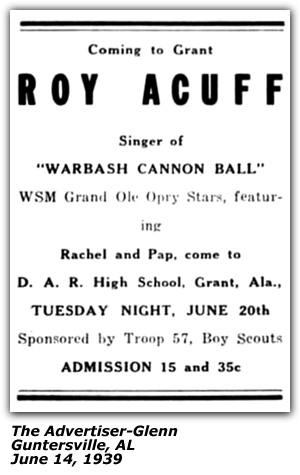
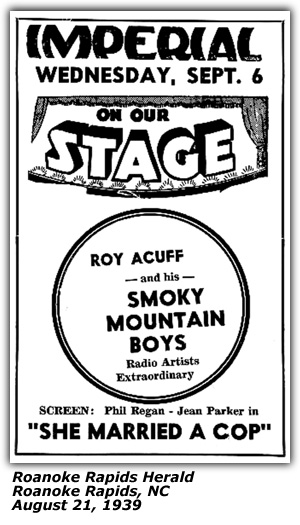
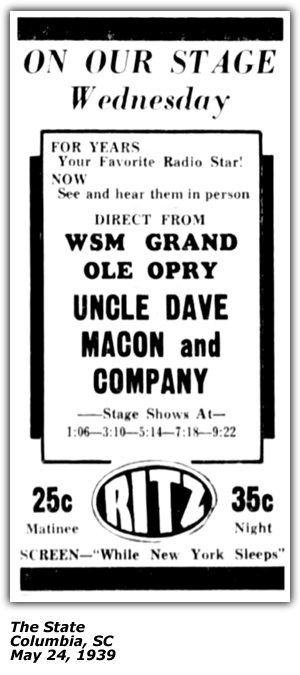
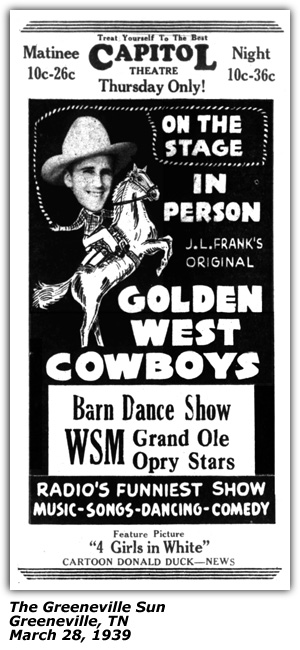
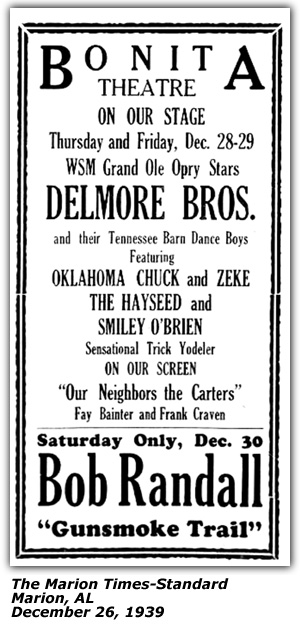
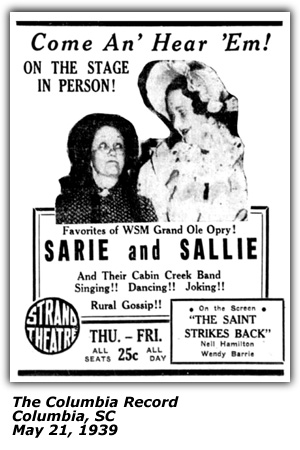
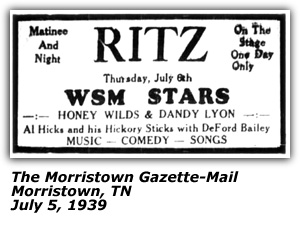
| Time | Artist(s) |
| 8:00 | Possum Hunters |
| 8:15 | Uncle Dave Macon |
| 8:30 | Bill Monroe |
| 8:45 | Sam and Kirk McGee |
| 9:00 | Jack and Mo. Mtneers. |
| 9:15 | Crook Brothers |
| 9:30 | Roy Acuff |
| 9:45 | President Roosevelt, NBC |
| 10:00 | Gully Jumpers |
| 10:15 | Zeke Clements |
| 10:30 | Stacey Sisters |
| 10:45 | Possum Hunters |
| 11:00 | Andrews Brothers |
| 11:15 | DeFord Bailey |
| 11:30 | Monk and Sam |
| 11:45 | Gully Jumpers |
| Source: | Nashville Banner - April 20, 1940 |
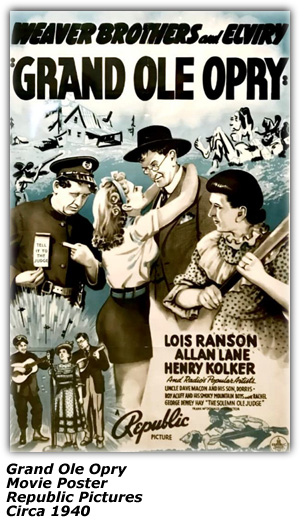
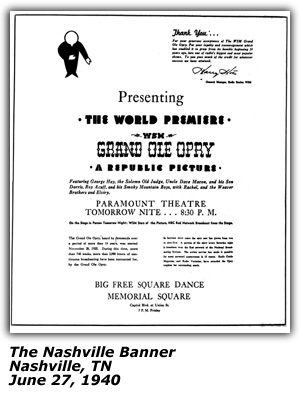
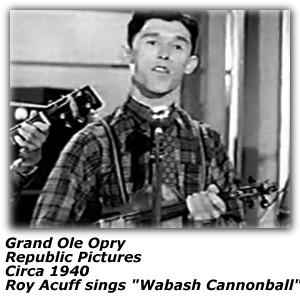 Roy Acuff and his Smoky Mountain Boys were a popular act on the Opry in 1940 in terms of the number of segments
they hosted according to newspaper radio logs of the year. Bill Monroe, Ford Rush, Uncle Dave Macon, DeFord Bailey
and Zeke Clements were other popular acts hosting more than 40 segments during the year. A popular duo was
the Stacey Sisters (Marie Stacey Dilleha and Nola Stacey), appearing 48 times. The string bands were again well
represented by the Crook Brothers, the Possum Hunters, the Fruit Jar Drinkers and the Gully Jumpers appearing
in more than 25 percent of the time slots.
Roy Acuff and his Smoky Mountain Boys were a popular act on the Opry in 1940 in terms of the number of segments
they hosted according to newspaper radio logs of the year. Bill Monroe, Ford Rush, Uncle Dave Macon, DeFord Bailey
and Zeke Clements were other popular acts hosting more than 40 segments during the year. A popular duo was
the Stacey Sisters (Marie Stacey Dilleha and Nola Stacey), appearing 48 times. The string bands were again well
represented by the Crook Brothers, the Possum Hunters, the Fruit Jar Drinkers and the Gully Jumpers appearing
in more than 25 percent of the time slots.
In May of 1940, Roy Acuff and his Smoky Mountain Boys, Uncle Dave Macon, The Solemn Old Judge himself George D. Hay went to Hollywood, California to make a movie with the Weaver Brothers and Elviry called "Grand Ole Opry." It appears there is no DVD version of the movie available, but it can be seen on youtube. The plot of the movie is not about the Opry, but perhaps it was an attempt to get the Opry stars on the movie screens.
Fans will recognize some of the regulars such as Sam and Kirk McGee, Zeke Glements, Jack Shook and his Missouri Mountaineers, and the Golden West Cowboys as well.
As usual, some new faces arrived on the scene in 1940. Early on, a comedy team of Monk and Sam appeared frequently between January and June. They were Samuel Johnson and Charles Olaf Hansen (a native of England). They had worked together for many years, in vaudeville. They were quite popular on WNOX in Knoxville in the late 1930's.
In December 1940, a young female comedienne began showing up in the radio logs - Minnie Pearl.
The Wilburn Children and The Wilburn Family also appeared on the Opry in 1940.

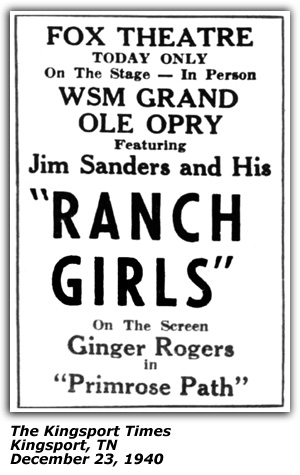
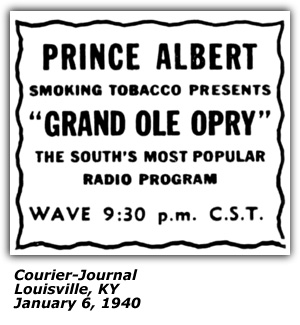

| Time | Artist(s) |
| 8:00 | Roy Acuff |
| 8:15 | Uncle Dave Macon |
| 8:30 | Minnie Pearl |
| 8:45 | Crook Brothers |
| 9:00 | Fruit Jar Drinkers |
| 9:15 | DeFord Bailey |
| 9:30 | Ford Rush |
| 9:45 | Jamup and Honey |
| 10:00 | Possum Hunters |
| 10:15 | Williams Sisters |
| 10:30 | Bill Monroe |
| 10:45 | Sam and Kirk McGee |
| 11:00 | Jim Sanders Ranch Girls |
| 11:15 | Zeke Clements |
| 11:30 | Robert Lunn |
| 11:45 | Paul and Bert |
| Source: | Nashville Banner - April 19, 1941 |

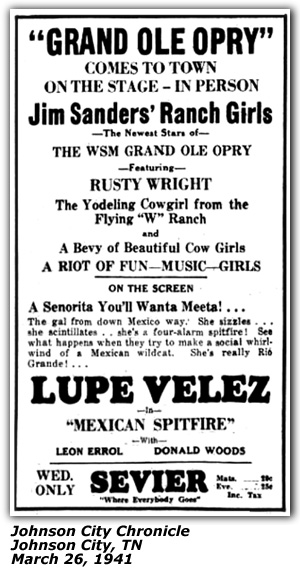
On May 24, 1941, WSM broadcast a half-hour from NBC from Enric Madriguera (B: February 17, 1902 — D: September 7, 1973). He was said to be a violinist born in Barcelona, Spain. He started his own orchestra in 1932 at the Biltmore Hotel. Sources indicate he played Latin American music almost exclusively in the 1930's. Later, he was declared "Ambassador of Music to all the Americas." His theme song was "Adios."
| Time | Artist(s) |
| 8:00 | Gully Jumpers |
| 8:15 | Uncle Dave Macon |
| 8:30 | Roy Acuff |
| 8:45 | Possum Hunters |
| 9:00 | Robert Lunn |
| 9:15 | Ford Rush |
| 9:30 | Minnie Pearl |
| 9:45 | Golden West Cowboys |
| 10:00 | Stacey Sisters |
| 10:15 | Tommie Thompson |
| 10:30 | Bill Monroe |
| 10:45 | Sam and Kirk McGee |
| 11:00 | Zeke Clements |
| 11:15 | Velma Williams |
| 11:30 | Fruit Jar Drinkers |
| 11:45 | Crook Brothers |
| Source: | Nashville Banner - April 18, 1942 |


From July 1942 through February 1943, a young female Nashville singer and guitar player by the name of Betty Owen was the name seen in the radio logs for segments on the Opry. All the more remarkable may be the fact that she was only 17 at the time she first appeared on the Opry. Other details are scant, but it was reported she was born nine months after the Opry had its first broadcast. She was still in school during this time and would do personal appearances with other Opry members. It was said that her father gifted her with an accordion when she was just eight years old. The boy next door got a guitar for Christmas one year and soon the two of them were doing duets. They liked each other's instrument so much they swapped. Betty became an accomplished guitar player. Little else has been found of her life and career after her last Opry appearance in the radio logs in February 1943.
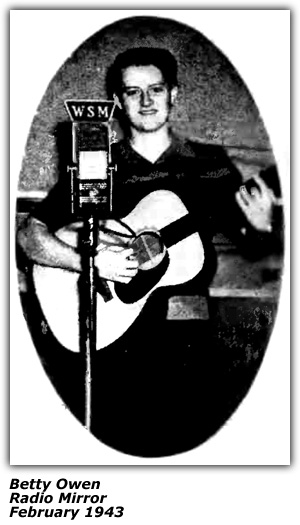
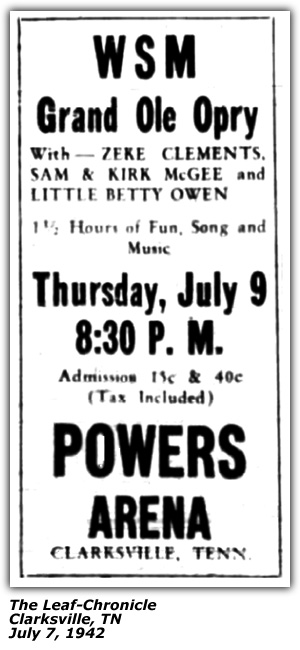
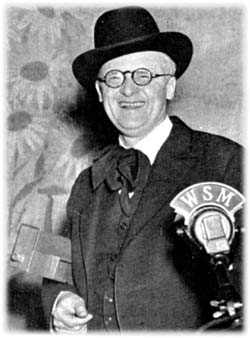 Finally, in 1943, the Opry moved to the Ryman Auditorium out of necessity.
The Ryman had been built in 1891 as the legend goes, by a riverboat
captain by the name of Tom Ryman. He came to a religious tent meeting
to heckle a preacher, but instead stayed and converted his life. He then
built the structure for the Reverend Sam Jones. Because there was a
Confederate Veterans reunion in 1897, a balcony was added
for the meeting to the auditorium. By then, the Ryman could seat some
3,000 people.
Finally, in 1943, the Opry moved to the Ryman Auditorium out of necessity.
The Ryman had been built in 1891 as the legend goes, by a riverboat
captain by the name of Tom Ryman. He came to a religious tent meeting
to heckle a preacher, but instead stayed and converted his life. He then
built the structure for the Reverend Sam Jones. Because there was a
Confederate Veterans reunion in 1897, a balcony was added
for the meeting to the auditorium. By then, the Ryman could seat some
3,000 people.
And there the Opry stayed until March 16, 1974 when the new Opryland complex opened. But still, the Ryman Auditorium kept its place in history. On occasion, the Opry moves its shows to the Ryman to keep in touch with its historical base. Shows are still held there. Fans can also take tours of the home of Country Music as some will call it.
This author can remember visiting the old Ryman Auditorium in the heat of a summer with his family. People were lined up outside the auditorium, waiting for their turn to attend the show. Hand fans were being sold by little kids in the streets, surely no one would want to not get one as the heat was stifling. In the street, one could hear the music being played over the loudspeakers at a nearby record store. We can remember Charley Pride's latest tune being played then - a song from a cut of his Tenth Album, "Able Bodied Man"; yes, we remember trivial details. Through the years, we made several pilgrimages to visit the show, with a college roommate, with family or alone. If you go to Nashville, you make a point to attend WSM's Grand Ole Opry.
| Time | Artist(s) |
| 7:00 | Roy Acuff |
| 7:15 | Roy Acuff |
| 7:30 | Dr. LeGear Melody Men |
| 7:45 | Golden West Cowboys |
| 8:00 | Bill Monroe |
| 8:15 | Uncle Dave Macon |
| 8:30 | Gully Jumpers |
| 8:45 | Crook Brothers |
| 9:00 | Robert Lunn |
| 9:15 | Minnie Pearl |
| 9:30 | Paul Howard |
| 9:45 | Jamup and Honey |
| 10:00 | Marie and Clyde Dilleha |
| 10:15 | Daniel Quartet |
| 10:30 | Roy Acuff |
| 10:45 | Sam and Kirk McGee |
| 11:00 | Zeke Clements |
| 11:15 | Milo Twins |
| 11:30 | Fruit Jar Drinkers |
| 11:45 | Possum Hunters |
| Source: | Nashville Banner - April 17, 1943 |
The year of 1943 saw an Opry roster that was consistent throughout the year after an examination of the radio logs published in both The Nashville Tennessean and Nashville Banner. The show was broke into 15-minute segments from 7:00 pm to 11:45pm each week. Of those 1,040 time slots, 14 artists and/or groups took up nearly 72 per cent of those slots. This would include stars such as Roy Acuff, Minnie Pearl, Bill Monroe, Uncle Dave Macon and Ernest Tubb. In that grouping were the traditional string bands, Gully Jumpers, Fruit Jar Drinkers and the Crook Brothers and Sam and Kirk McGee. Artists and their bands were represented by Golden West Cowboys (led by Pee Wee King), the Daniel Quartet, Paul Howard and his Cotton Pickers. Comedy during the year was provided by Minnie Pearl (and on two occasions with "Maria"), Whitey Ford and Jamup and Honey.
Roy Acuff was listed in the most time slots in 1943 - 81 times. From January through May 22, 1943, he opened the show during the firs two segments - 7:00-7:15 and 7:15-7:30. He also appeared in the 10:30-10:45 slot until October. After October, he was not on the show.
It is interesting to note the relatively fixed format of the show's line up each week in 1943. Several acts appeared in the same 15-minute segment throughout the entire year. These acts were Uncle Dave Macon (8:15-8:30), Bill Monroe (8:00-8:15), the Crook Brothers (8:45-9:00), the Gully Jumpers (8:30-8:45), the Fruit Jar Drinkers (11:30-11:45), the Possum Hunters (11:45-12:00), the Daniel Quartet (10:15-10:30) and Sam and Kirk McGee (10:45-11:00).
Other names that appeared a few times were Trudy Brown, Payne Patrick who was on two shows, Betty Owen and a group called the Old Timers Quintet.
Trudy Brown was part of an attempt to inaugurate a 'new idea in serviceman's shows' on the Opry. She was a well known Nashville radio personality. A group of servicemen were selected to be a part of the show would Trudy. Before the show, she was going to telephone parents and friends of the servicemen to find out what they wanted to hear from the service men chosen. She would then pose the questions to the servicemen on the air during her portion of the show.
Marie Stacey, one of the Stacey Sisters appeared five times as a solo act, mentioned probably erroneously as a duet with "Marie and Clyde Moody" (25 times!) and also more likely should have been Marie and Clyde Dilleha (21 times) which means she was on the Opry pretty much every week in 1943.
A group known as Dr. LeGear's Melody Men was listed 17 times. The name was probably the name of a sponsor at the time, though research has not shown who the "Melody Men" were.
Other acts appeared for a time during the year such as the Milo Twins, Zeke Clements, the Smith Sisters, Robert Lunn, Tomie Thompson, the Missouri Mountaineers, the Old Timers Quintet. Eddie Arnold is listed in the latter part of the year, a couple times as a solo act, in other times with the Southern Aggies.
Of the 1,040 time slots in 1943, only 36 different acts were listed in those slots.
Occasionally readers would learn of guests on the Opry. On January 23, 1943, Jimmie Davis was in town for a hearing of the Tennessee Gas and Transmission company before the State Railroad and Public Utilities Commission and the Federal Power Commission, made an appearance on the Opry, though the article did not mention which segment he appeared on.
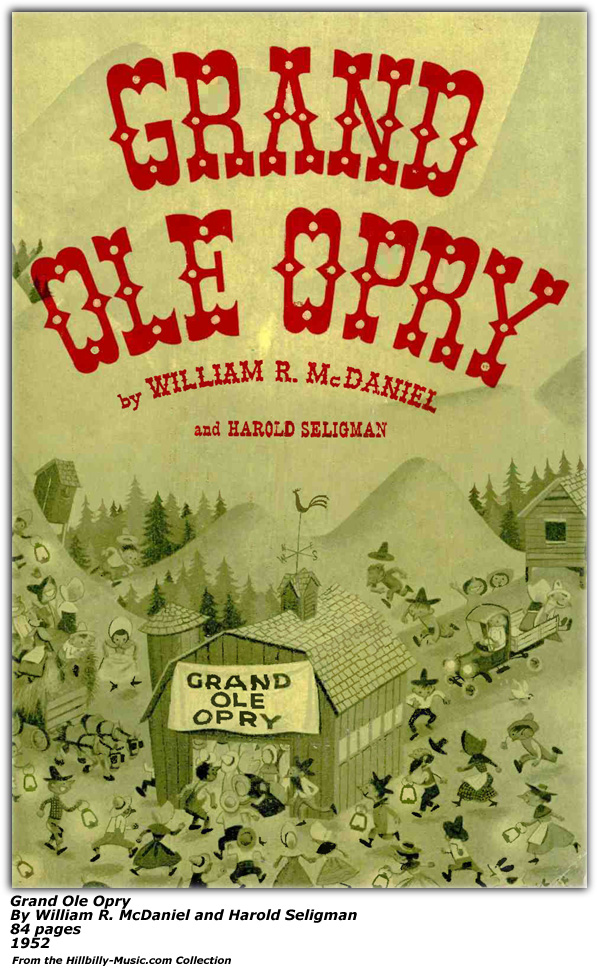
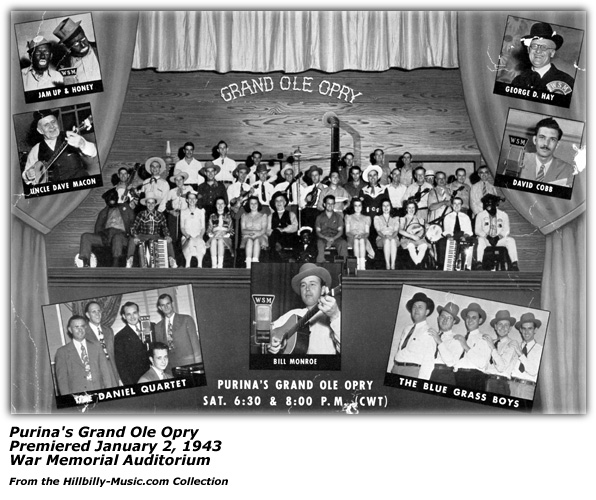
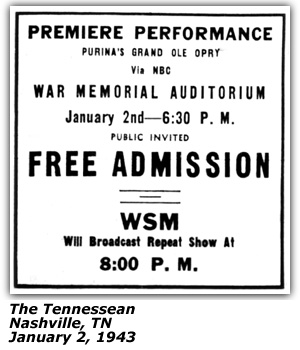
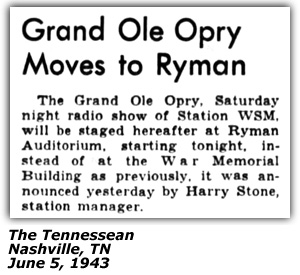
| Time | Artist(s) |
| 8:00 | Bill Monroe |
| 8:15 | Jamup and Honey |
| 8:30 | Possum Hunters |
| 8:45 | Crook Brothers |
| 9:00 | Golden West Cowboys |
| 9:15 | Georgia Peach Pickers |
| 9:30 | Roy Acuff |
| 9:45 | Whitey Ford |
| 10:00 | Bill Monroe |
| 10:15 | Uncle Dave Macon |
| 10:30 | Roy Acuff |
| 10:45 | Eddy Arnold |
| 11:00 | Paul Howard |
| 11:15 | Ernest Tubb |
| 11:30 | Golden West Cowboys |
| 11:45 | Zeke Clements |
| Source: | Nashville Banner - April 15, 1944 |
In 1944, World War II was having an impact on the entertainment industry. Many events were held to help raise funds for the war effort. The Grand Ole Opry stars and other country entertainers were a part of that effort.
A couple of new names showed up on the schedule of acts performing on the Opry in 1944. In late 1944, the name Dave Minor was listed in the WSM radio logs at midnight on Saturday nights. Technically perhaps not part of the Opry show itself, but it raises an interest in research. Mr. Minor had a radio show where he played the piano, but also sold his how to learn the piano booklets / courses. He was based in Chicago. His real name was David M. Suttle. Research shows he did record one album - "88 Keys At 80." He had moved to San Diego by that time in retirement. His usually 15-minute show was found listed in many a radio log. Another new name was that of Uncle Rufus Brewster.
In the early part of 1944, Roy Acuff was considering running for governor of Tennessee. It may have started as a prank. But it seemed to take on a life of its own and soon politicians and reporters started to take it more seriously. Paul Morris quoted one unnamed politician, "I'd rather run against the best qualified man in the state than to make a race against that fiddler!"
Politics was not the only topic of discussion with Mr. Acuff. During the year, he began to market "Roy Acuff's Own Flour (Plain and Self-Rising)."
On November 29, 1944, The Nashville Banner reported the news that the Solemn Old Judge was leaving WSM. He had been the voice of the Grand Ole Opry since it started in 1925. He planned to move his wife to the west coast for her health. The thought was he would take on character roles in movies for such studios as Columbia and Republic. He did have a role in one movie, "Hoosier Holiday."
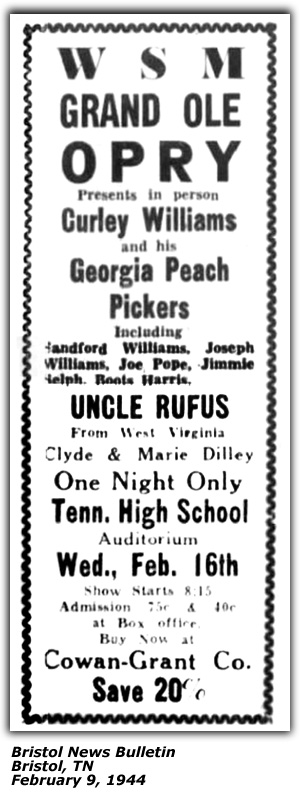
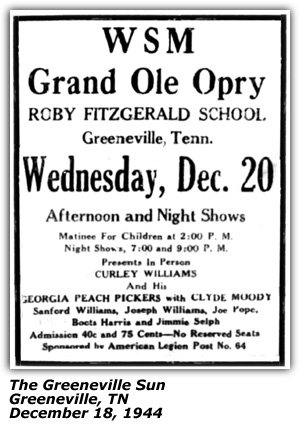
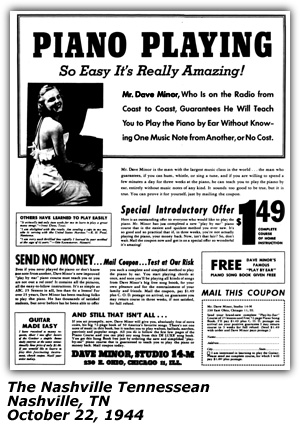
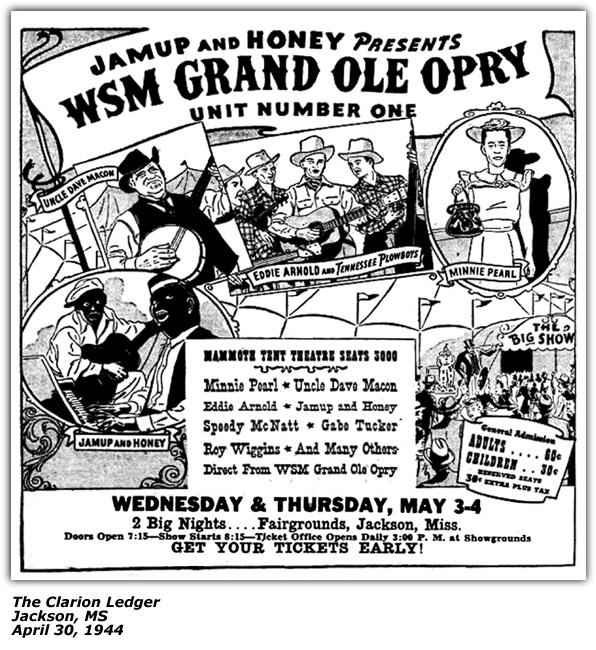
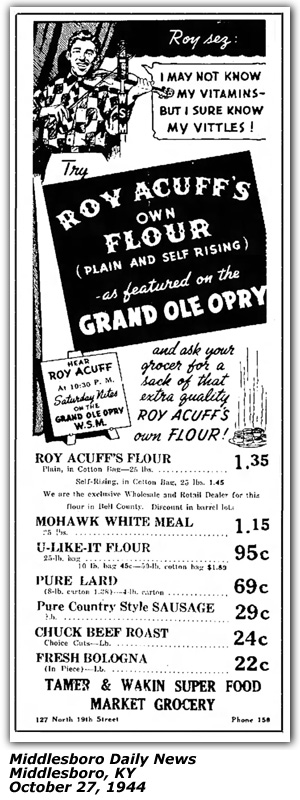

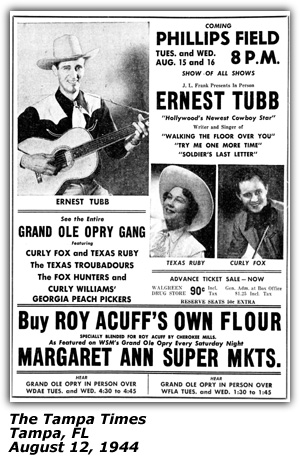
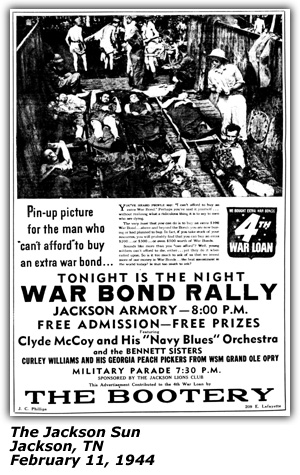
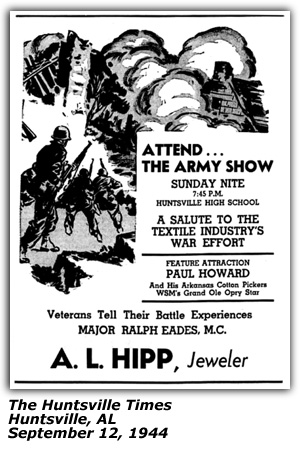
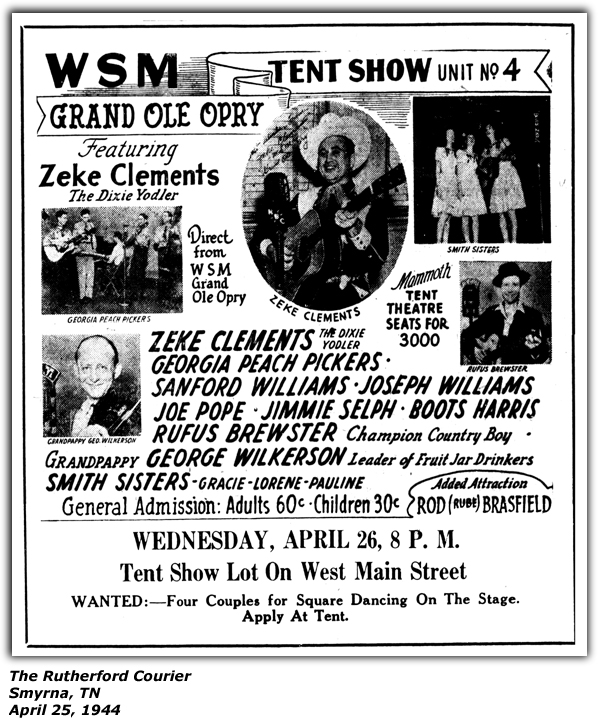
| Time | Artist(s) |
| 8:00 | Eddy Arnold |
| 8:15 | Rod Brasfield |
| 8:30 | Zeke Clements |
| 8:45 | Paul Howard |
| 9:00 | Ernest Tubb |
| 9:15 | Peach Pickers |
| 9:30 | Roy Acuff |
| 9:45 | Duke of Paducah |
| 10:00 | Bill Monroe |
| 10:15 | Uncle Dave Macon |
| 10:30 | Roy Acuff |
| 10:45 | Lew Childre |
| 11:00 | Roy Acuff |
| 11:15 | Ernest Tubb |
| 11:30 | Golden West Cowboys |
| 11:45 | Fruit Jar Drinkers |
| 12:00 | Dave Minor |
| Source: | Nashville Banner - April 21, 1945 |
Dave Minor's program continued to air at midnight on Saturday nights after the Grand Ole Opry program. His show was carried on numerous stations. In January of 1945, his program aired over the following stations: WSAI - Cincinnati, OH; KFAB - Lincoln, NE; WBAL - Baltimore; WFIG - Sumter, SC; KXOK - St. Louis, MO; KRLD - Dallas, TX; WPIC - Sharon, PA; and, WJJD - Chicago, IL;
The Opry radio logs in 1945 introduced the "Frank Sinatra of the Opry" - Jimmy Selph. He was listed on only a couple of segments, but promotional ads did play up the comparison to Frank. For a time, he was part of a traveling show called the Mountain Scandals that also included a former WLS performer, Barbara Jeffers.
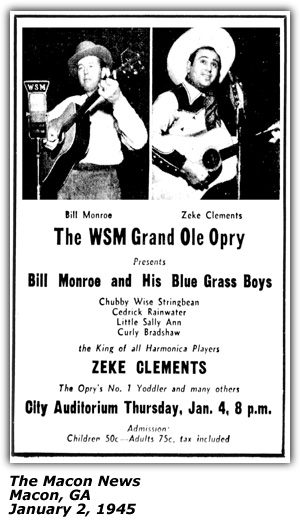
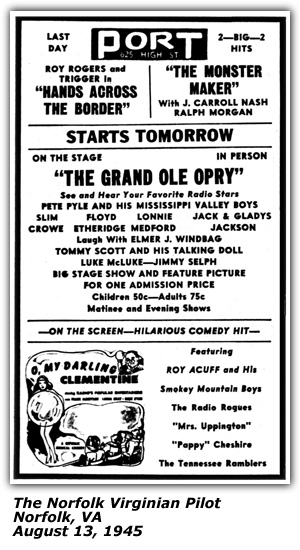
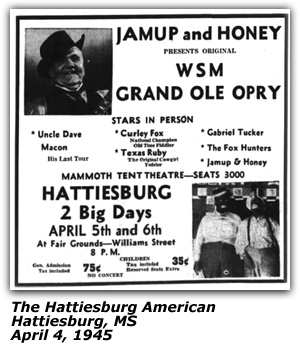
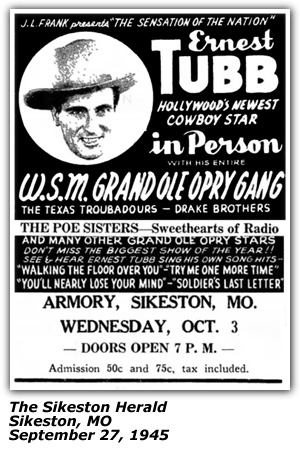
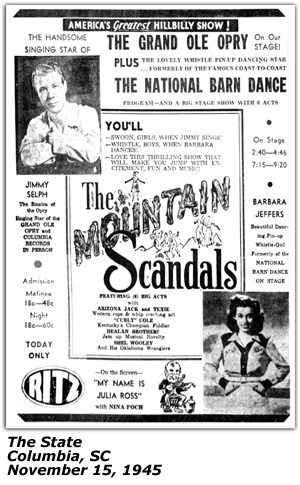
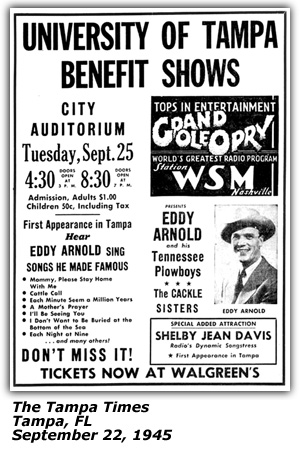
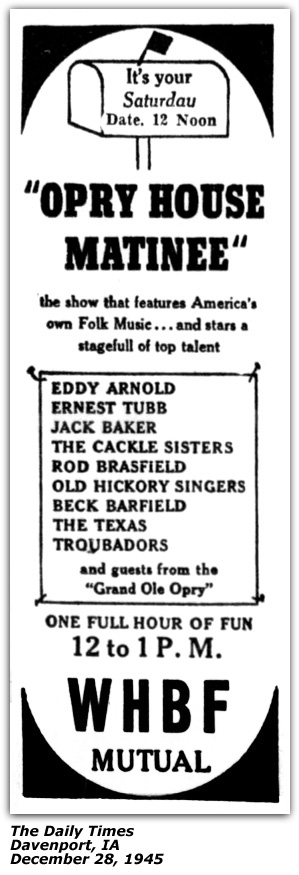
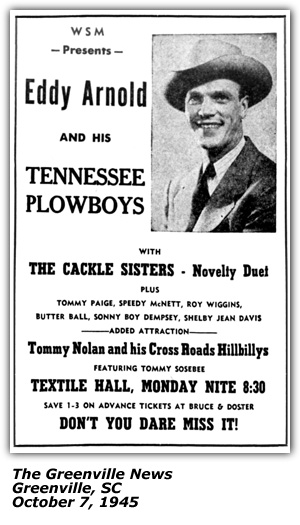
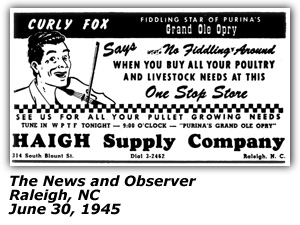
| Time | Artist(s) |
| 7:00 | Ernest Tubb |
| 7:15 | Ernest Tubb |
| 7:30 | Musical Millers |
| 7:45 | Paul Howard |
| 7:45 | Minnie Pearl |
| 8:00 | Uncle Dave Macon |
| 8:15 | Bailes Brothers |
| 8:30 | Paul Howard |
| 8:45 | Clyde Moody |
| 9:00 | Ernest Tubb |
| 9:15 | Golden West Cowboys |
| 9:30 | Roy Acuff |
| 9:45 | Duke of Paducah |
| 10:00 | Bill Monroe |
| 10:15 | Curly Fox and Texas Ruby |
| 10:30 | Roy Acuff |
| 10:45 | Eddy Arnold |
| 11:00 | Roy Acuff |
| 11:15 | Ernest Tubb |
| 11:30 | Robert Lunn |
| 11:45 | Fruit Jar Drinkers |
| Source: | Nashville Tennessean - April 20, 1946 |
August 1946 saw a unique event happen for the WSM Grand Ole Opry. Texas Ranchman E. Paul Waggoner signed a contract in early August 1946 that would take the Opry broadcast out of Nashville for the first time in its 20 year history. The occasion was the first annual North Texas Fair at Arlington Downs. Harry Turpin of Arlington and secretary of the fair and Harry L. Stone, manager of the Opry witnessed the contract signing. The Opry remote broadcast would begin at 8:30 pm. Red Foley, the Duke of Paducah, the Old Hickory Singers and Minnie Pearl were some of the stars scheduled to appear at Arlington Downs that night.
Another act on the Opry during this era was the Old Timer's Quartet. They were led by Claude Sharpe who did the arranging, directing and managing the group. Also a part of the group were Joseph McPherson, Luther Heatwole and Ross Dowden. A 1946 article in The Nashville Tennessean quoted Claude, "We specialize in old barbershop numbers." The same group of four men also performed as the "Old Hickory Singers."
One could not help but notice that of all the acts listed in the Opry radio logs of 1946, only one female person showed up over 60 times - comedian Minnie Pearl. The Poe Sisters hosted four segments during the year. Texas Ruby shared billing with her Co-star, Curly Fox on 49 Opry segments. This is not to say that there were not female performers appearing during the segments as guests - this is an observation of just the acts in the newspaper logs.
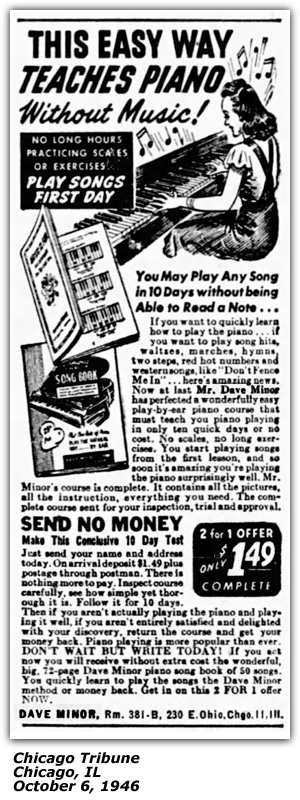
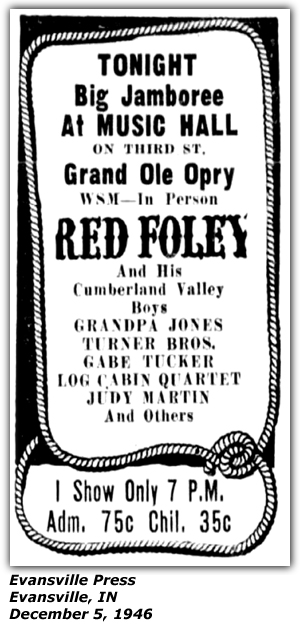



| Time | Artist(s) |
| 7:00 | Bradley Kincaid |
| 7:15 | Bradley Kincaid |
| 7:30 | Milton Estes |
| 7:45 | Pee Wee King |
| 8:00 | Eddy Arnold |
| 8:15 | Oklahoma Wranglers |
| 8:30 | Lew Childre |
| 8:45 | Robert Lunn |
| 9:00 | Golden West Cowboys |
| 9:15 | Johnny and Jack |
| 9:30 | Red Foley |
| 9:45 | Rod Brasfield |
| 10:00 | Bill Monroe |
| 10:15 | Paul Howard |
| 10:30 | Curley Fox |
| 10:45 | Pee Wee King |
| 11:00 | Eddy Arnold |
| 11:15 | Ernest Tubb |
| 11:30 | Wally Fowler |
| 11:45 | Milton Estes |
| Source: | Nashville Tennessean - April 19, 1947 |
| Time | Artist(s) |
| 7:00 | Ernest Tubb |
| 7:15 | Musical Millers |
| 7:30 | Roy Acuff |
| 7:45 | Roy Acuff |
| 8:00 | Eddy Arnold |
| 8:15 | Oklahoma Wranglers |
| 8:30 | Ernest Tubb |
| 8:45 | Lew Childre |
| 9:00 | Roy Acuff |
| 9:15 | Cowboy Copas |
| 9:30 | Red Foley |
| 9:45 | Rod Brasfield |
| 10:00 | Bill Monroe |
| 10:15 | Old Timers Quartet |
| 10:30 | Curly Fox and Texas Ruby |
| 10:45 | Milton Estes |
| 11:00 | Eddy Arnold |
| 11:15 | Ernest Tubb |
| 11:30 | Wally Fowler |
| 11:45 | Milton Estes |
| Source: | Nashville Tennessean - April 17, 1948 |
| Time | Artist(s) |
| 7:00 | Bill Monroe Bradley Kincaid Milton Estes Roy Acuff |
| 8:00 | Cowboy Copas Bill Monroe Ernest Tubb Lew Childre |
| 9:00 | Roy Acuff Jamup and Honey Red Foley Minnie Pearl |
| 10:00 | Bill Monroe Roy Acuff Cowboy Copas Milton Estes |
| 11:00 | George Morgan Ernest Tubb Jimmy Dickens Wally Fowler |
| Source: | Nashville Tennessean - April 16, 1949 |

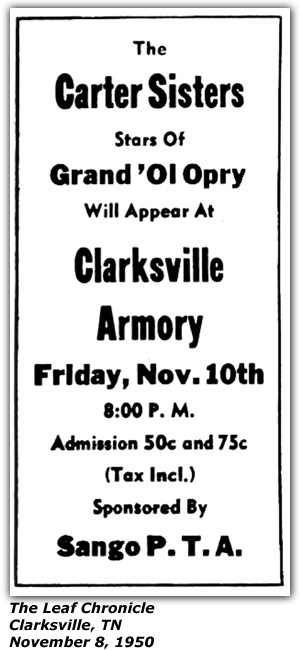
| Time | Artist(s) |
| 6:00 | Cowboy Copas |
| 6:00 | Little Jimmy Dickens |
| 6:00 | Hank Williams |
| 6:00 | Hank Williams |
| 7:00 | Ernest Tubb |
| 7:00 | Carter Sisters |
| 7:00 | Roy Acuff |
| 7:00 | Lew Childre |
| 8:00 | Ernest Tubb |
| 8:00 | Little Jimmy Dickens |
| 8:00 | Cowboy Copas |
| 8:00 | Duke of Paducah |
| 9:00 | Hank Williams |
| 9:00 | Roy Acuff |
| 9:00 | Red Foley |
| 9:00 | Minnie Pearl |
| 9:00 | Rod Brasfield |
| 10:00 | Bill Monroe |
| 10:00 | Roy Acuff |
| 10:00 | Ernest Tubb |
| 10:00 | Carter Sisters |
| 11:00 | Cowboy Copas |
| 11:00 | Hank Williams |
| 11:00 | Hank Snow |
| 11:00 | George Morgan |
| Source: | Nashville Banner - April 21, 1951 |
| Time | Artist(s) |
| 6:00 | Cowboy Copas |
| 6:00 | Little Jimmy Dickens |
| 6:00 | Hank Williams |
| 6:00 | Hank Snow |
| 7:00 | Ernest Tubb |
| 7:00 | Carter Sisters |
| 7:00 | Roy Acuff |
| 7:00 | Lew Childre |
| 8:00 | Ernest Tubb |
| 8:00 | Little Jimmy Dickens |
| 8:00 | To Be Announced |
| 8:00 | To Be Announced |
| 9:00 | Roy Acuff |
| 9:00 | George Morgan |
| 9:00 | Carl Smith |
| 9:00 | Duke of Paducah |
| 10:00 | Bill Monroe |
| 10:00 | Roy Acuff |
| 10:00 | Ernest Tubb |
| 10:00 | Little Jimmy Dickens |
| 11:00 | Carl Smith |
| 11:00 | Cowboy Copas |
| 11:00 | Hank Snow |
| 11:00 | George Morgan |
| Source: | Nashville Banner - April 19, 1952 |
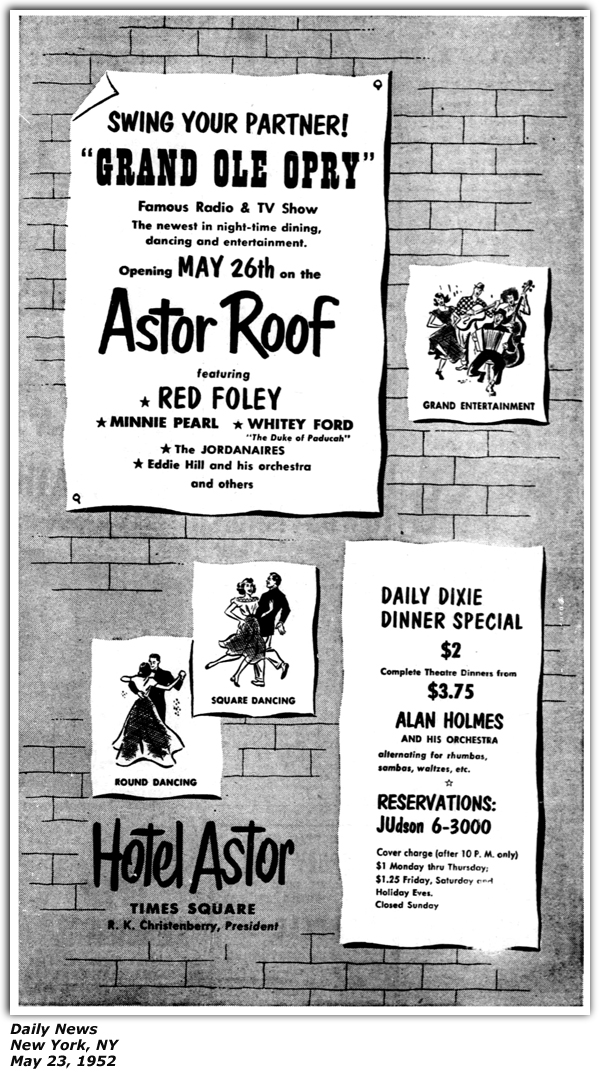
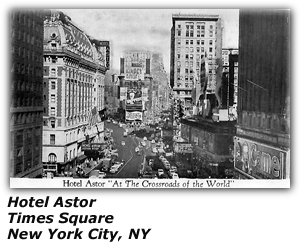

In 1952, Smilin' Eddie Hill left for New York on May 24. He was to be the emcee for a summer long Grand Ole Opry contingent entertaining folks on the roof of the Hotel Astoria in New York City for 16 weeks. The Nashville newspapers dutifully covered the event. Reportedly the flight to New York encountered some turbulence which allegedly caused Little Jimmy Dickens to tell a stewardess "Tell the driver of this here airplane that if he can find a hole in the fence I'd appreciate it if he would get back on the road." The opening night of the long engagement was to be broadcast over WSM from 11:30 pm to Midnight on Monday, May 26. In another groan of a tidbit, supposedly Murray Harmon, drummer for Eddie Hill, was selling "popcorn" during the flight. But the bags were not "popcorn" bags.
Eddie Jones of the Nashville Banner wrote, "A handful of Nashville hillbillies turned Broadway into Main Street here last night when the Grand Ole Opry took over the Hotel Astor roof." The house was packed for the kick-off of sixteen weeks of performances by the Opry contingent. Red Foley and Minnie Pearl ere there and would rotate on two week engagements. The show featured a throw back to Opry roots when the Solemn Ole Judge George D. Hay brought his steam boat whistle to open the first night. Judge Hay made note of the Opry beginnings, "About 27 years ago we started this show with Uncle Jimmy Thompson and his fiddles. Within a few weeks we grew to a staff of 25 performers. In the past 27 years we have grown to where we now have a staff and cast of 125."
Red Foley opened the music doing "San Antonio Rose." Tennessee's Governor Browning was on hand, taking time off from his re-election campaign. Other performers that first night were The \ Jordanaires (Bill and Monty Matthews; Hoyt Hawkins; Culley Holt), Martha Carson, Adrian McDowell, Tommy Jackson, Murray Harmon, drummer, Dean Maddock (piano), Bud Isaacs (guitarist), Floyd Clarice (fiddle), Bill Burks, accordion. The Candy Mountain Girls also performed, a group that included Betty Sanders, Corrine Whyland and Mary Jane Johnson.
The president of the Astor Hotel was Robert Christenberry, a native of Milan, TN) who happened to be a cousin of the Tennessee governor. He was quoted in a June article by United Press, "I used big name slick orchestras for many years, but recently the public has not been as responsive to their lure as in the past. I decided it would be smart to try something else for the roof, and this group has enough variety and personnel to keep the show fresh over the entire summer."
United Press went on to state, "This is the first time the big town (New York) has had a chance to see these radio stars who stick close to Nashville without sacrificing anything in the way of income or prestige. Some of the singers are among the nation's top record sellers, by-passing many of the better publicized stars."
Another article told readers that the Astor roof decorations included backdrops similar to the ones fans saw at the Ryman Auditorium.
Jane Carter reported on some of the reviews the Opry engagement received elsewhere. Variety wrote,
"This is undiluted cider
jug entertainment which should draw the visiting mountain folk as well as a passel of New Yorkers with a hankering for hayseed.
It's a good pitch for warm weather trade.
Red Foley, the revue continued, "toplines the layout with a brace of current folk numbers as well as a rundown
of all the hinterland hits of recent times from "Tennessee Waltz" to "Chattanooga Shoe Shine Boy." It's a good straight
vocal turn.
The revue reports that Minnie Pearl has a "good style" for the genre and appeals with her infectiously energetic delivery."
The Jordanaires "sock across a repertory of spirituals and the Eddie Hill orchestra supplies "the right kind of background
for this type of show."
The original contract with the Astor Hotel called for the Opry acts to perform through September 13, 1952. But Billboard reported that several telephone conversations took place between WSM executives and Bob Christenberry, head of th eAstor. The article stated "... basic reason for canceling according to a WSM statement was "the high cost of the show in relation to the fact that night club business in New York is generally off this season." Hotel Astor execs confirmed that. It was reported that it was costing the hotel about $5,000 a week, far in excess of what the hotel usually paid for entertainers on the Roof, usually name bands.
Reportedly the booking of the Opry was initiated by Christenberry. Usually MCA (Music Corporation of America) booked the bands for the hotel - for years. It was said Broadway veterans were surprised at the booking even though the Opry was the country's top hillbilly program and the success of appearances on the Kate Smith New York television shows.
But behind the scenes, the hotel, MCA and others were trying to make changes in the Opry performances at the venue. WSM was reluctant to change the authentic Opry format to fit into a conventional night club show to try and draw larger crowds. It became apparent the night club experience where dining and drinking were more the focus than the entertainment were not a mix for the Opry.
It seems there were misgivings about the endeavor from the beginning by the artists who are used to more of an interaction with audiences and were not familiar with a night club audience. They were also taking a substantial pay cut for the engagement. While reviews were generally favorable, it was felt that the Opry was a bit out of place in the swanky atmosphere found on the Astor Roof.
The size and layout of the room also had an impact and the sound system was deemed inadequate, making it difficult for the acts to be heard.
Billboard provided some other details not seen in other articles in a review of the Opry performance in a June 7, 1952 review. The capacity of the Astor Roof was 850. Pricing for the shows was $1.00 to $1.50 minimum. The estimated budget for the show was $5,000. It was also noted that the sound system was not up to par - instrumental backing was too loud and drowned out the singers at times.
United Press wrote an article printed in the Nashville Banner on June 21 that the show put on by Opry performers "drew very good crowds." But indicated some performers were "less happy with their reception from the crowds that "practically had to wear gloves to get in" and chomped celery during the performance.
Dub Albritten, a producer noted, "We're just not a night club act and we won't change our act for anything." While the Opry played before packed theaters, arenas throughout the country — including Carnegie Hall —. But the Astor audiences were of a different type. Roy Acuff said, "But this is a down-to-earth program. You've gotta pull your hair down and get down with the boys. Why, this hotel won't even let them on the elevator without coats on. You practically have to wear gloves to ever get in. They're too dressed up to get in the spirit of country entertainment." The UP article implied audiences were thinking the Opry performance was meant to be "corny comedy." Mr. Albritten noted, "They came to laugh at us, and when they found it wasn't the sort of thing to be laughed at, they didn't know how to take it."
At the end of the first two weeks, Local 802 of the musicians union gave a two-week notice to the cast of performers. Roy Acuff was due to perform starting the third week. If was felt that anyone could increase the audiences attending, it would be Roy. The business did pickup but not significantly. It was thought that fans of country music stayed away "...because of the high cost of an evening in a hotel." The early closing meant that acts such as Hank Williams, Hank Snow, Ernest Tubb, Jimmy Dickens, Carl Smith and the Carter Sisters would not play before the New York audiences. On June 23, the Astor Roof went back to its old bookings - Carman Cavallaro and his orchestra replaced the Opry acts.
Reviews in publications such as Variety perhaps showed a bit of New York / urban bias against performers seen as rural. For example, "With Red Foley at the helm, the program sped through 30 minutes of unadulterated alfalfa."
This would not be the first attempt to broaden the audiences of country music as well as the Grand Ole Opry. Perhaps it was before its time. But one can imagine the performers in their western garb mingling with the city folks of Times Square during the evenings. Readers might also check out the story of Sunshine Sue and the WRVA Old Dominion Barn Dance. They tried to bring country music to a theater on Broadway for several weeks from September 13, 1954 to October 2, 1954.
The year of 1952 included a major departure of one of the stars of the Grand Ole Opry. The news came over the wires from Nashville on August 14, 1952. WSM had released / fired Hank Williams from the Grand Ole Opry. The Associated Press reported that "A spokesman for WSM said Williams violated the terms of his contract when he failed to appear on the station's Grand Ole Opry last Saturday night (August 9) and missed a personal appearance Sunday (August 10)." The newspaper radio logs did not list Hank as appearing on the Grand Ole Opry on August 9, but the Nashville Banner did list him as being on the Opry on August 16 while the Tennessean did not.
The story in the Nashville Tennessean on August 15 stated WSM had "concluded his contract Aug. 11, according to Jim Denny, WSM artists service representative. After his termination, he left for Montgomery, AL. Later reports came in that Hank was in the hospital in Louisiana and began performing on the KWKH Louisiana Hayride. On Sunday, October 18, 1952, Hank married Billie Jean Jones in two public ceremonies in New Orleans, LA as part of a public appearance.
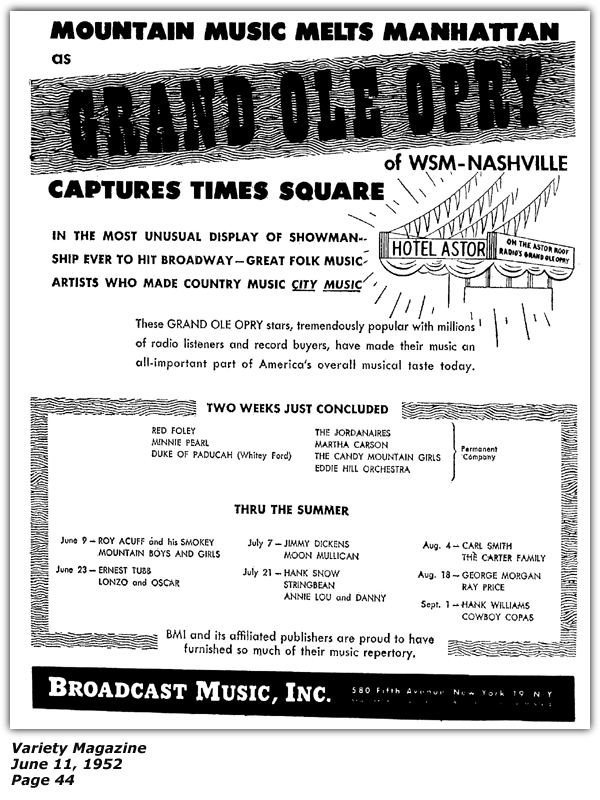
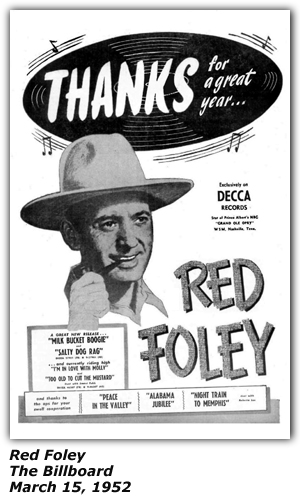
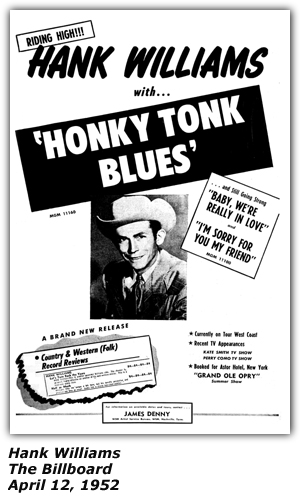
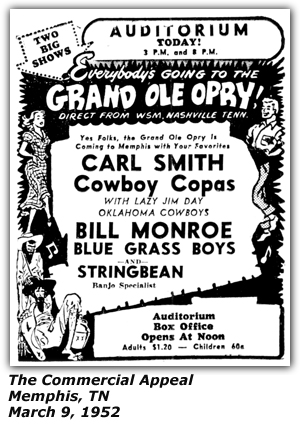
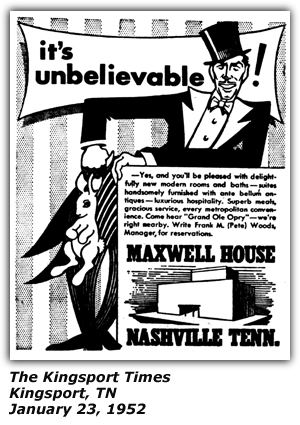
| Time | Artist(s) |
| 6:00 | Ray Price |
| 6:15 | Little Jimmy Dickens |
| 6:30 | Roy Acuff |
| 6:45 | Little Jimmy Dickens |
| 7:00 | Webb Pierce |
| 7:15 | Ray Price |
| 7:30 | Roy Acuff |
| 7:45 | Tommy Sosebee |
| 8:00 | Ernest Tubb |
| 8:15 | Carter Sisters |
| 8:30 | Red Foley |
| 8:30 | Minnie Pearl |
| 8:45 | Rod Brasfield |
| 9:00 | Roy Acuff |
| 9:15 | Lonzo and Oscar |
| 9:30 | Carl Smith |
| 9:45 | Little Jimmy Dickens |
| 10:00 | George Morgan |
| 10:15 | Webb Pierce |
| 10:30 | Ernest Tubb |
| 10:45 | Little Jimmy Dickens |
| 11:00 | Roy Acuff |
| 11:15 | Carl Smith |
| 11:30 | Hank Snow |
| 11:45 | Webb Pierce |
| 12:00 | George Morgan |
| Source: | Nashville Banner - April 18, 1953 |
| NOTE | On the weekend of January 17 and 18, 1954, The Nashville Tennessean and The Nashville Banner stopped pubishing the radio and television logs. The newspapers wanted a contract with a daily service charge to publish the information in the form of a non-cancelable three year-contract. On June 14, 1954, the newspapers announced an agreement had been made and the publishing of the logs began anew. |
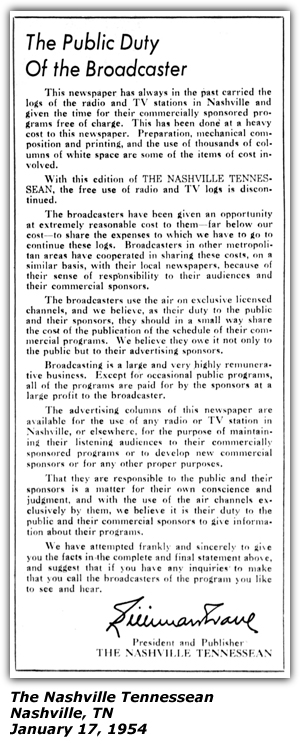
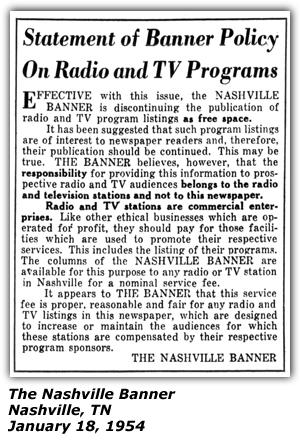
The reader will notice that this particular story of the Grand Ole Opry makes use of the radio logs that were published in the Nashville newspapers - The Tennessean and The Banner. However, during the research process, it was noticed that there was a gap in 1954. After we completed the task of capturing logs for Saturdays in the 1950's, another research effort was made - was there a reason why the radio logs ceased publication for a time. Yes, there was indeed a reason. Readers will note the similarity in today's media world of cable, satellite, streaming or over the air - someone wants a fee for doing so. The newspapers each published an editorial the week before they ceased publishing the logs. Simply put, they wanted reimbursement for the time and effort it took to make room for publication of such information. The Tennessean stopped publishing the logs on Sunday, January 17; The Banner, which did not publish on Sundays, stopped publishing the logs on January 18.
On June 14, 1954 both The Banner and The Tennessean announced an agreement had been reached and they would again resume publishing the radio and TV logs for WSM, WSM-TV and WLAC. Both papers made the announcement on page 1 of their editions. The Banner article noted that "...happy to restore these logs to its columns on the basis of a three-year, non-cancelable contract for a daily service charge, mutually acceptable to this newspaper and the owners of the respective radio and TV stations involved." The Banner also noted that the logs of any Nashville radio or TV stations would be carried when they have signed a similar contract with them. No other details were noted of this agreement.
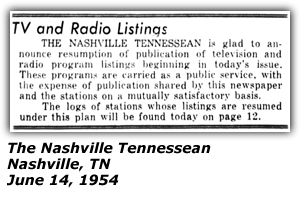
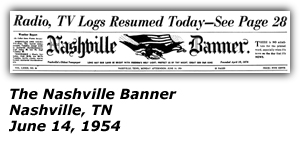

| Time | Artist(s) |
| 6:00 | Carl Smith |
| 6:15 | Grandpa Jones |
| 6:30 | Roy Acuff |
| 6:45 | Roy Acuff |
| 7:00 | Hank Snow |
| 7:15 | Lonzo & Oscar |
| 7:30 | Roy Acuff |
| 7:45 | Lew Childre |
| 8:00 | Ernest Tubb |
| 8:15 | Carter Sisters |
| 8:30 | Rod Brasfield |
| 8:45 | Minnie Pearl |
| 9:00 | Roy Acuff |
| 9:15 | Roy Acuff |
| 9:30 | Carl Smith |
| 9:45 | Carl Smith |
| 10:00 | George Morgan |
| 10:15 | Marty Robbins |
| 10:30 | Ernest Tubb |
| 10:45 | Little Jimmy Dickens |
| 11:00 | Webb Pierce |
| 11:15 | Carl Smith |
| 11:30 | Hank Snow |
| 11:45 | Lew Childre |
| 12:00 | Ernest Tubb |
| Source: | Nashville Banner - April 16, 1955 |
| Time | Artist(s) |
| 6:00 | Carl Smith |
| 6:15 | Grandpa Jones |
| 6:30 | George Morgan |
| 6:45 | Little Jimmy Dickens |
| 7:00 | Hank Snow |
| 7:15 | Lonzo & Oscar |
| 7:30 | Jim Reeves |
| 7:45 | Faron Young |
| 8:00 | Ernest Tubb |
| 8:15 | Flatt & Scruggs |
| 8:30 | Cowboy Copas |
| 8:45 | Louvin Brothers |
| 9:00 | Webb Pierce |
| 9:15 | Faron Young |
| 9:30 | Carl Smith |
| 9:45 | Little Jimmy Dickens |
| 10:00 | George Morgan |
| 10:15 | Flatt & Scruggs |
| 10:30 | Ernest Tubb |
| 10:45 | Hank Snow |
| 11:00 | Carl Smith |
| 11:15 | Lonzo & Oscar |
| 11:30 | Ray Price |
| 11:45 | Lou Childre |
| 12:00 | Ernest Tubb |
| Source: | Nashville Tennessean - April 21, 1956 |

| Time | Artist(s) |
| 6:00 | Roy Acuff |
| 6:15 | Porter Wagoner |
| 6:30 | Ray Price |
| 6:45 | Jimmy Newman |
| 7:00 | Hank Snow |
| 7:15 | Lonzo & Oscar |
| 7:30 | Roy Acuff |
| 7:45 | Faron Young |
| 8:00 | Flatt & Scruggs |
| 8:15 | Cowboy Copas |
| 8:30 | Little Jimmy Dickens |
| 8:45 | Johnny & Jack |
| 9:00 | Ernest Tubb |
| 9:15 | Little Jimmy Dickens |
| 9:30 | Hank Snow |
| 9:45 | Wilma Lee and Stoney Cooper |
| 10:00 | Roy Acuff |
| 10:15 | Marty Robbins |
| 10:30 | Little Jimmy Dickens |
| 10:45 | Faron Young |
| 11:00 | Ernest Tubb |
| 11:15 | Ferlin Husky |
| 11:30 | Hank Snow |
| 11:45 | Louvin Brothers |
| 12:00 | Ernest Tubb |
| Source: | Nashville Banner - April 20, 1957 |
| Time | Artist(s) |
| 6:00 | Roy Acuff |
| 6:15 | Everly Brothers |
| 6:30 | Johnny Cash |
| 6:45 | Cousin Jody |
| 7:00 | Hank Snow |
| 7:15 | Wilma Lee & Stoney Cooper |
| 7:30 | Roy Acuff |
| 7:45 | Johnny Cash |
| 8:00 | Flatt & Scruggs |
| 8:15 | Ray Price |
| 8:30 | Grand Ole Opry |
| 8:45 | Grand Ole Opry |
| 9:00 | Ferlin Husky |
| 9:15 | Johnny Cash |
| 9:30 | Hank Snow |
| 9:45 | Everly Brothers |
| 10:00 | Roy Acuff |
| 10:15 | Wilburn Brothers |
| 10:30 | Ray Price |
| 10:45 | Faron Young |
| 11:00 | Ferlin Husky |
| 11:15 | Everly Brothers |
| 11:30 | Ferlin Husky |
| 11:45 | Johnny Cash |
| 12:00 | Ernest Tubb |
| Source: | Nashville Banner - April 19, 1958 |
This begins our trip into history of the Grand Ole Opry. We have to start somewhere. We'll update the page from time to time with more tidbits on the history of the Opry. Each time you visit, you'll see a different list of the Grand Ole Opry in its earlier days. For now, we'll leave you with this sign-off by the Solemn Old Judge himself, George D. Hay:
The tall pines pine,
The pawpaws pause,
And the bumble-beee bumbles all day;
The eavesdropper drops,
And the grasshopper hops,
While gently the ole cow slips away
—Judge Hay's Valediction
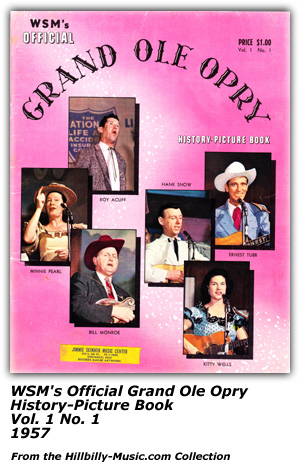
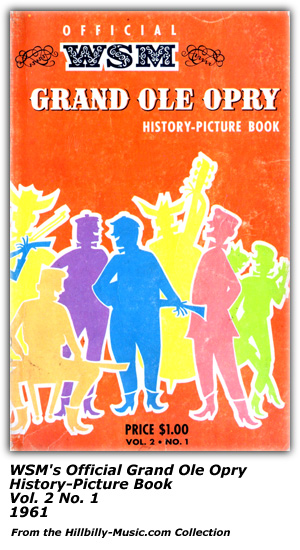
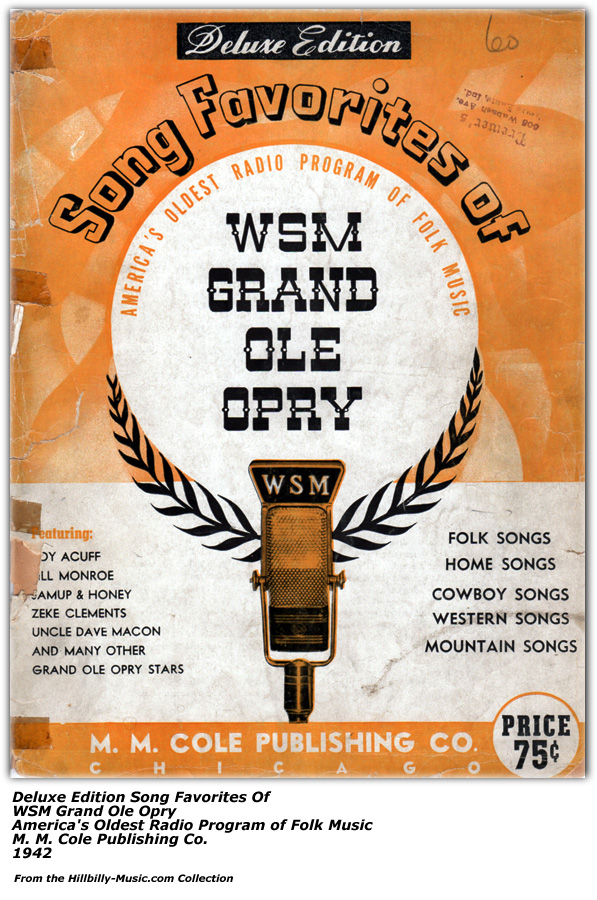
| Time | Artist(s) |
| 7:00 | Roy Drusky; Del Reeves; Charlie Walker; Jan Howard Cracker Barrel |
| 7:30 | Bill Anderson; Bob Luman; Jim and Jesse Varallo |
| 8:00 | Archie Campbell; Bobby Bare; Dottie West; Justin Tubb Odom Sausage; U.S. Borax |
| 8:30 | Roy Acuff; Jean Shepard; Stonewall Jackson; Wilma Lee and Stoney Cooper Kroger Stores |
| 9:00 | Wilburn Brothers; Osborne Brothers; Jeanne Pruett; Del Wood Baltz Bros.; Schlitz |
| 9:30 | Jim Ed Brown; Hank Locklin; Grandpa Jones; The Carlisles Acme Boot Co.; Beechnut Chewing Tobacco |
| 10:00 | Billy Walker; Charlie Louvin; Stu Phillips; The Willis Brothers Cee Bee Food Stores; Schlitz |
| 10:30 | George Morgan; The Four Guys; Ray Pillow; Lonzo and Oscar; Ernie Ashworth Shoneys Big Boy |
| Announcers | Grant Turner and Hairl Hensley |
| Opry Manager | Hal Durham |
| Source: | Grand Ole Opry Souvenir Program - March 15, 1974 |
Credits & Sources>
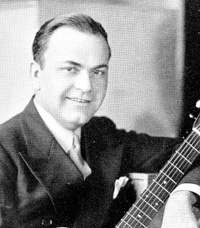
Chuck Haines (Chuck and Ray) |
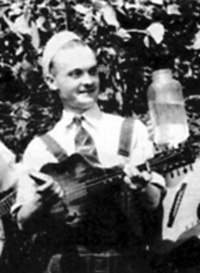
Tom Leffew |
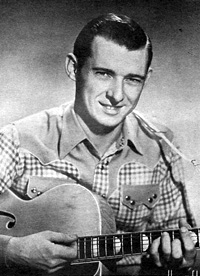
Randy Hughes |

Andrews Brothers |
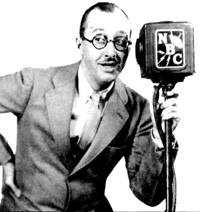
Raymond Knight and His Cuckoos |

Annie Lou Danny |

Wade Ray |
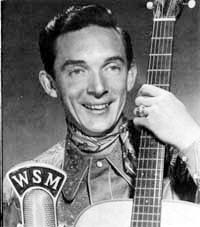
Ray Price and the Cherokee Cowboys |
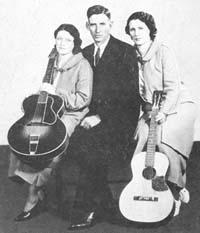
Carter Family |
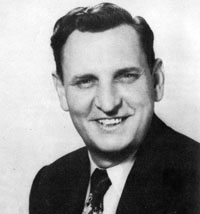
Clyde Moody |
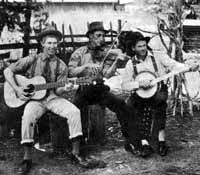
Dixieliners |

Jack Anglin |
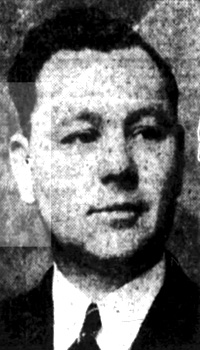
Elmo Phillips |
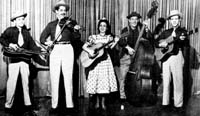
Wilma Lee & Stoney Cooper and Clinch Mountain Clan |
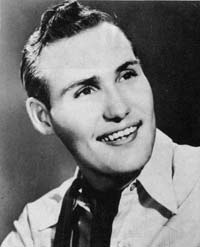
Billy Walker and the Traveling Texans |
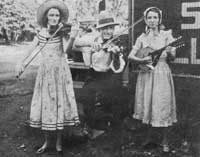
Theron Hale and His Daughters |

Vagabonds |
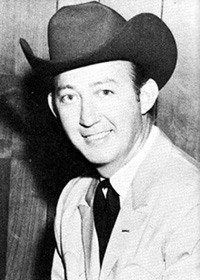
Jack Greene |

Oscar Stone and His Possum Hunters |
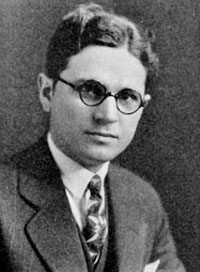
Bradley Kincaid |
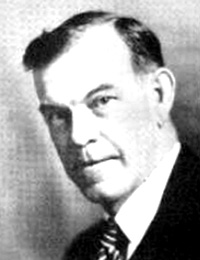
Obed Pickard |
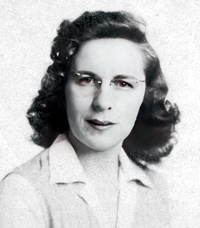
Alcyone Bate Beasley |
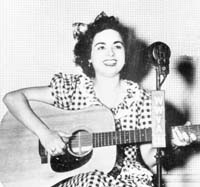
Wilma Lee Cooper |

Jimmie Riddle |

Rita Robbins |
Hillbilly-Music.com
Yes, Hillbilly Music. You may perhaps wonder why. You may even snicker. But trust us, soon your feet will start tappin' and before you know it, you'll be comin' back for more...Hillbilly Music.
Hillbilly-music.com ...
It's about the people, the music, the history.
|
Copyright © 2000—2023 Hillbilly-Music.com
|
||||